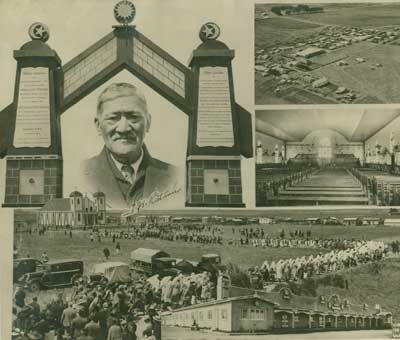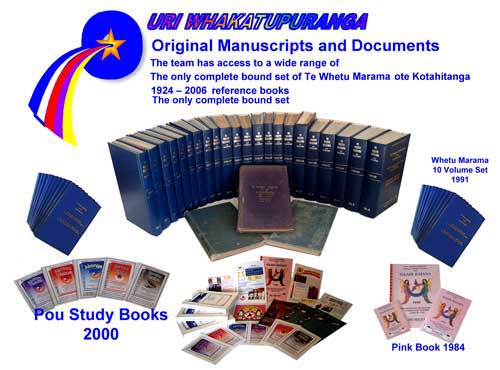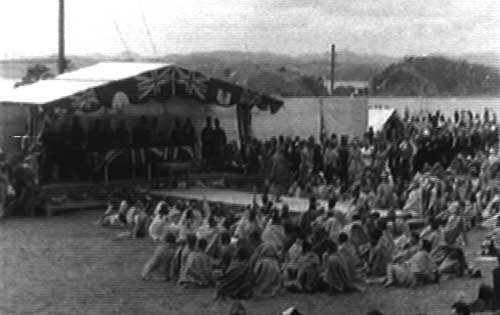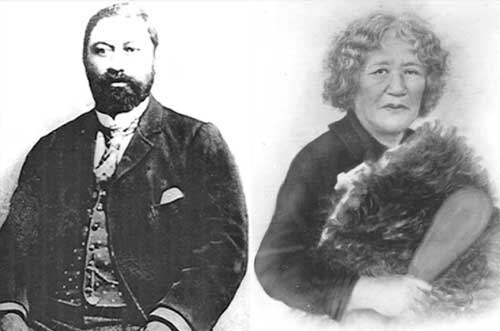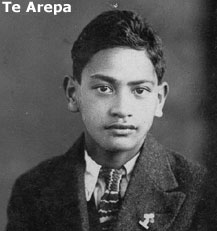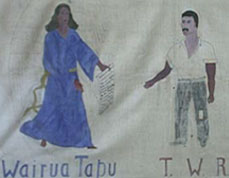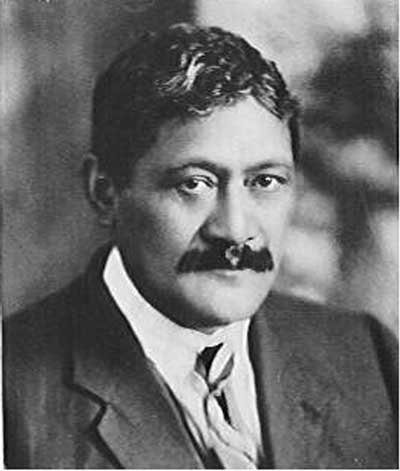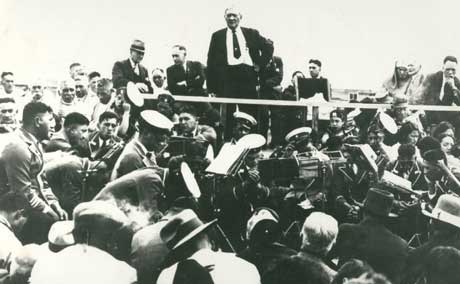

Home | E
Tahupotiki Wiremu Ratana | Two Whales | The Vision | The Testing | Te Whaea Katoa
Ministry T.W.Ratana | Age of the Miracles | 1921 South Island Tour | Hamuera
1934-1935 Period | Archway Consecration | 1936 Period | 1937 Omeka Pa | Buildings
RATANA HISTORY PAGE INTRODUCTION
Tenei te mihi kia koutou, nga Kai Hapai te Rama, me nga Morehu nui tonu i runga ano i te tuku na Ihoa O nga Mano, Te Matua, Tama, Wairua Tapu, me nga Anahera Pono, me te Mangai hei tautoko mai aianei ake nei Ae.
|
Arahi .R. Hagger Masters Thesis 2003: The information on this website is thoroughly researched and chronologically listed into historical categories from a, (Masters Thesis) The Last of the Great Prophets, Sacred Icons of the Ratana Movement and Ratana Church, completed in 2003. The information is sourced and gathered from Te Whetu Marama O Te Kotahitanga 1924-1939, Te Rongo Pai Hou A T.W.Ratana Mangai, Nga Akoranga, Uri Whakatupuranga Ratana Archive Research Centre, oral history, live documentary interviews. personal family diaries, unpublished manuscripts, handwritten journals and old photo albums from the Morehu around New Zealand and those living in Ratana Pa. Information also sourced from newspaper clippings, handwritten World Tour Journals 1924-25, old black and white films, world tour newpapers, Online web search Japan, Great Britian, United States America, Canada, Europe, South Africa, Pacific Islands, Australia, New Zealand, Archives and Museums. Welcome to the official Website of the Ratana Established Church of New Zealand 2003, aimed at making available online historical and theological history of Ratana Movement and the Ratana Church to all Morehu and other parties interested in T.W.Ratana twent year ministry. The Website was designed by Arahi .R. Hagger. The information for the website was also gathered and sorted by the members of Uri Whakatupuranga, Puawai Hagger, Tracey Hancy, Kereama Pene, Hareruia Aperahama, Arahi Hagger. On the 8th November 2003, the Ratana Archive Research Centre was spiritually opened, and the release of the Official Ratana Church Website was launched. The trial run for the website will enable the Morehu to access information about their Maramatanga (Enlightenment), in chronological format the history about the early days of the Ratana Movement and the Ratana Church. This will allow each individual to understand Tahupotiki Wiremu Ratana's mantle he undertook as Te Mangai, and Piri Wiri Tua in his twenty year ministry. Many stories will unfold, but the legacy of this Maramatanga will always endure to the end of time.
This Divine Revelation was revealed to Tahupotiki Wiremu Ratana on the 8th Novemeber 1918. In 1924, T.W.Ratana "Mangai" spoke these words to the workers in the Whetu Office. "Ko Koe te Reo o Te Mangai me Piri Wiri Tua, haere whakaatutia Taaku e mea Ai". (You are the voice of both Te Mangai and Piri Wiri Tua, go forth)
Modern scholars tell us that more than 15,000 years ago we lived on the land now called China, and travelled via Taiwan, the Philippines to Indonesia around 6,000 to 9,000 years ago. Movement continued through Melanesia and reached Fiji about 3,500 years ago. The journey proceeded onto Samoa and the Marquesas 2,500 years ago. Our Ancestors detoured south West to Tahiti, via the Cook Islands, journeying to Aotearoa, New Zealand their final resting place.
In light of the above, Maori have been able to trace their lineage through Whakapapa, (genealogy) individual tribes have their own identity, its law, which is based on its founding teachings. This form of knowledge is known today as Kawa, Tikanga and Kaupapa Maori "knowledge” has been preserved and practiced through medium of waiata, carvings, korero (word of mouth), poropiti, to select individuals who endowed with special gifts to foresee the future. They were given insight to the past and visions for the future. Legends of their homeland called Hawaiki were staunchly embraced and spoken about. Tribal stories were handed down through Whakapapa tell Maori after the death of body our spirits journey back to Hawaiki; to the homeland of the spirits world. Maori were fully enriched with tradition, and were able to embrace a system of understanding. This was defined to the Tohunga as Mana (Power) or Mauri the (Life Force) from whence Maori Priesthood of the Whare Wananga (house of sacred learning) was being utilised. Understanding of the stars and ocean currents is passed down; the Tukutuku clearly speaks for itself particularly when being observed in weaving which adorns the walls of carved embellished Whare (house). Numerous Tukutuku panels descend from star charts carried by ancient navigators prior to both the introduction of the first Missionaries and the Bible to Aotearoa. Maori practiced the laws of Io (God). Chants and rituals were performed, every Mihi, every Whaikorero on the Marae, the gathering of the people, recall these ancient teachings. Maori were not in the dark about the beginning of creation they believed they were part of this life force. Understanding why Maori are close to nature is no great mystery. Maori Mihi to Tree's (Tane Mahuta) and the animals (Nga kararehe) of the forest, the sea (Tangaroa), to the sky, Rangipapa (father of heaven), and to the earth, Papatuanuku (mother earth), with all due respect given to the (supreme being), who blessed Tangata Te Whenua with the role of "Kaitiaki O Nga Taonga Katoa, (guardians of creation). Maori Version“"Engari i pupu ake he kohu i te whenua, na reira i whakamakuku te mata katoa o te oneone."” English Translation"But there went up a mist from the earth, and watered the whole face of the ground." (Wai) (Genesis 2:6) Maori Version“"Na ka whakaahuatia te tangata E Ihoa, te Matua, he puehu no te oneone, a whakahangia ana e ia ki roto ki ona ponogaihu te mamawa ora, a ka wairua ora te Tangata."” English Translation"And the Lord God formed man of the dust of the ground and breathed into his nostrils the breath of life;" (Ha) "and man became a living soul." (Ki) (Genesis 2:7) (Te Pihopatanga o Aotearoa Rotorua: 1992) The ancient schools of learning, (Whare Wananga) taught that our ancestors were formed from a combination of dust, earth and the mist which rose from it, filled with the breath of God. This was defined as the Ha (breath of life). Through the nostrils our ancestor were given Life. Thus to Maori they retain this most Tapu (sacred) act, which continues to be performed. This is known as the Hongi, (pressing together of noses) a sign that Maori had their relationship with God the Father the Giver of life. Maori legends teach of the mighty "Kaitiaki" with powers of control over the elements, the fish of the sea, the birds of the sky. (Kara Book Pene K, 1990: pg1)
“A kahore he ahua o te whenua, i takoto kau; He pouri ano a runga i te mata o te hononu. Na ka whakapaho te Wairua o te Matua i runga i te kare o nga wai.” English TranslationAnd the earth was without form, and void; and darkness was upon the face of the deep. And the Spirit of God moved upon the face of the waters.” (Genesis 1:2) Creation of this world by IO (Supreme Being), to the Maori, meant that water was life, without water there was only death, this act is seen at the birth of a new born baby, and the water breaks through, then the cutting of the umbilical cord. The kupu (word) wai (water) became used in the Maori language to symbolise spiritual power in the form of Te Wairua (the spirit), Te Waiora, (waters of life), and Te Puna Waiora (the fountain of the waters of life). Maori Version“Na ka manaakitia raua e Te Matua ki a raua, kia tini, kia kapi hoki Te Whenua i a korua, kia mate hoki ona tara i a korua; ko korua hei Rangatira mo te ika o te Moana, mo te manu hoki o te rangi, mo nga mea ora katoa ano hoki e nga kingaoki ana i runga i te whenua.”
And God blessed them, and God said unto them, be fruitful and multiply, and replenish the earth, and subdue it; and have dominion over the fish of the sea, and over the fowl of the air, and over every living thing that moved upon the earth.” (Genesis 1:28) (Te Pihopatanga o Aotearoa Rotorua: 1992)
The Tiriti O Waitangi signed by Crown representatives with over 500 chiefs remains a central issue in New Zealand, which still leaves much division between Maori, Pakeha, and the Crown as it was in 1840. The decision of the Crown to step in and resolve matters was, to all intents and purposes, aimed at protecting the rights of both the Maori people and the new settlers. There are many aspects concerning the Tiriti O Waitangi that will come up for discussion with the Treaty of Waitangi having modifying influence on offical dealings with Maori people and more generally the New Zealand public attitudes, compared to the European of the 1800, had a determination to dominate with colonial domination of indigenous races. The gap between Maori and European expectations of the Tiriti O Waitangi still remains unbridged. (Orange C. 1987: Pg5; Akoranga Anaru, 1997: pp17-18; Facsimiles of the Treat of Waitangi)
This list of Maori Prophets, prophesied the coming of Tahupotiki Wiremu Ratana. Several important prophetic comments were made by each Maori Prophet concerning Ratana. The Maori people were in need for someone to deliver them from the bonds of Tohungaism and evil practices of black magic. This person would unite the Maori people under Ihoa O Nga Mano. The Prophets of Maoridom in their Prophesies spoke of how the people would identify this man when he arrives and foretold the coming of the deliverer who would have the Maramatanga. Records and references to these Prophets maybe found in the full set of Te Whetu Marama o te Kotahitanga. This material gives a broad explanation on the events a chronological map of the Ratana Movement and the Ratana Church during Tahupotiki Wiremu Ratana ministry between 1918 and 1939. However, the fact that the coming of a deliverer, who would have the Maramatanga with him was foretold. (Pene K, 1990: pg40) |
Last of the Great Prophets (Maori Faith Healer) Tahupotiki Wiremu Ratana was born at midday on 25th January 1873, at Kawau, in the Rangitikei district south of Whanganui. His father was Te Urukohai (1845-1911) and his mother was Ihipera Koria (1847-1925). Wiremu’s family genealogy can be traced back to both the Aotea and Kurahaupo Waka. His tribal ancestries are Ngati Apa, Nga Rauru, Nga Waiaiki and Ngati Hine. Wiremu’s whakapapa connections are also linked to the people from Taranaki, and are of Ngati Ruanui and Ngati Raukawa decent. Wiremu Ratana was fostered out a week after his birth and raised by his foster mother Ria Te Ra I Kokiritia Ai Hamuera. He was baptised into the Methodist church at one month old. In those days it was customary for many Maori families to whangai their children to extended family members in this case with Wiremu, there were too many children for his parents to bring up. At the age of eight, he was sent to Kai Iwi School near Awahuri on State Highway 3, north of Whanganui, and at fourteen Wiremu, was shown how to work the farm doing odd jobs such as fencing, clearing the scrub, dairy farming taking care of livestock. At the seventeen, he returned to his grandfather, Ngahina Te Pakaru Ratana (1830-1911) living at the family homestead Orakeinui, Waipu Block. (Te Rongo Pai Hou A T.W.R.Mangai, Volume One: 1930-40; Henderson J, 1963: pg22) (Akoranga Anaru, 1997: pg52) Ngahina taught Wiremu how to cultivate the farmland to be aware of the responsibilities and duties, which lay ahead that God would reveal to him in the near future. During this period, Wiremu became one of the top ploughmen around Manawatu district; his peers both Maori and Pakeha respected him. In his free time, Wiremu participated in football and had a reputation, as “furious player” he also participated in other sporting activities one interest in particular was the love for training racehorses. In 1893, Tahupotiki Wiremu Ratana married Urumanao Ngapaki Baker (1873-1940) from Patea; she was a member of the Methodist faith. Their wedding was held at the Methodist Church at Parewanui. Wiremu and Urumanao’s union was fruitful producing eight children; some were whangai to extended family members. (Te Rongo Pai Hou, Sheet 3, Volume One 1930-40; J.M.Henderson, 1963: pg22; Akoranga, Anaru, 1997: pg52) |

Their eldest son Tokouru was born in 1894, their daughters Maata Tawhirimatea was born 1904, Rawinia in 1906, with the youngest of the girls Piki was Te Ora born in 1908. In 1910, Urumanao gave birth Te Arepa (Tommy) and the (first Omeka) who passed away at infancies. Their third son Matiu was born in 1912, with the second Omeka (Joe Mick) born in 1916. The young couple eventually returned to Orakeinui, Waipu block south of Whanganui where they settled to work in earnest. During the early stages of Wiremu and Urumanao’s marriage, his grandfather Ngahina insisted Wiremu attend the theological school to study the bible and acquire knowledge in reciting scriptures. Because of the poor eyesight, his vision affected his work; unfortunately, Wiremu was unable to complete his bible studies. After his disappointing exit from the theological school, Wiremu began indulging in the material things of the world; his grandfather’s hopes of Wiremu completing his studies were incomplete.
(Te Rongo Pai Hou, Sheet 4, 1930-40; J.M.Henderson, 1963: pg22; Akoranga Anaru, 1997: pg52)
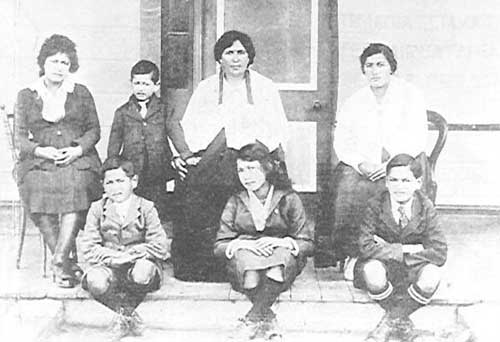
In 1910, Wiremu’s aunt, Mere Rikiriki the Prophetess who was anointed by the Holy Spirit, in the presents of the Arch Angel Gabriel declared to the Maori people of the land, about certain prophecies. These prophecies mention by some of the greatest Maori prophets who lived during the 1800s, prophets like Hipa Te Maiharoa, Te Kooti Rikirangi, Whiti and Tohu, Tawhiao and many other gifted seers.
English Translation
“O people of the land, hasten unto me, the woman, I have peace,
in a while it shall be upon a man, who will take action directly and strongly,
without favoritism” He Ringa Poto He Ringa Kaha.” Wi (short for Wiremu) return to your home and take with you the God of
your Ancestors, the God of Abraham, the God Issac, the God Jacob, so that
the light shall shine among you both and your children.
On this occasion, Wiremu’s grandfather asked him to accompany him to Parewanui to receive spiritual guidance from his aunt Mere Rikiriki. However, Wiremu did not wish to be associated with such matters of the spirit he was more involved with the material things of the world. Wiremu believed the names that were placed upon his sons were to high but his grandfather told him, that the Holy Spirit bestowed the names upon the two boys to be materialised on the face of the earth. (Akoranga Anaru, 1997: pg53)
Ngahina Te Pakaru Ratana passed away in 1911, and the following year 1912, his father Wiremu Kowhai passed away. The passing away of his grandfather and father was a great lose to Wiremu. Ngahina and both of Wiremu’s parents as well as the teachings from his aunt Mere Rikiriki (Prophetess) influenced his early adult life.
(Te Rongo Pai Hou, 1930-40; Akoranga Anaru, 1997: pg52 )
In 1912, Wiremu and his family travelled back to Parewanui in the presents of his aunt Mere Rikiriki where she confirmed and endorsed what his grandfather Ngahina declared the children are to be baptised as Te Arepa and Te Omeka. She did not have that spiritual authority to lay hands upon the boys. When it was time for then to return home Mere Rikiriki spoke to Wiremu saying:-
“Wi, return to your home and take with you the God of your Ancestors, the God of Abraham, The God Isaac, The God Jacob, so that the light shall shine among you both and your childr
(Te Rongo Pai Hou, Sheet 3 Volume One: 1930; Akoranga Anaru, 1997: pg53)
Shortly after arriving home their son, Te Arepa fell ill, they decided to travel back Parawanui to Mere Rikiriki. When they arrived at Mere’s, she made them wait for 24 hours without touching the child. Wiremu became stressed and asked why nothing had been done, why she ignored the child. Mere Rikiriki replied, “that this child’s name was too high that his name was endowed with spiritual powers”. However, a short time later Wiremu and Urumanao decided to take their son to Patea. The young family travelled to Patea with one of the elders, where there was a large gathering of people waiting. Te Poi Awarua, who was married to Ratana’s sister Te Raupo, repeated what Mere Rikiriki had said. “I am not able to administer healing prayers, for the child is endowed with spiritual powers, the child is above me, for his name is directly from the Lord himself.” However, Te Raupo convinced him to take action so Te Poi turned toward the sick boy and prayed that he be healed. Everyone was amazed when the boy began to recover instantly. However, there was to be a terrible price paid, as soon as Te Arepa received his healing Te Poi lost his eyesight and the gift of healing right to his passing away. (Te Rongo Pai Hou Sheet 4, Volume One 1930-40; J.M.Henderson, 1963: pg25)
Two Whales |
The Signs 17th March 1918 |
 |
On March 17th, 1918, Wiremu Ratana took his family fishing near a sheltered inlet between the Whanganui and the Rangetikei River where the canoes used to come a shore blown by the strong westerly winds the crashing of the waves on the rugged west coast. While they enjoyed their time fishing Wiremu spotted from a distance a large wave forming in size making its way to shore. The wave headed directly towards them, then suddenly the large mountainous wave crashed upon shoreline, it broke and slowly reseeded back to sea; behind it appeared a large whale. Wiremu and his family were amazed looking at each while in a state of shock at what they just witnessed. Several minutes later to their amazement another large mountainous wave appeared in the distance, as they looked in wonder this wave was similar to the first wave, following the same path. |
However, this wave broke ealier than the previous wave at the water edge then another whale appeared thrashed about then became still. It started bleeding profusely with it’s blood flowing back into the sea. As this whale lay motionless, the place became inundated with fish. Suddenly fish were scattered all around the whale flapping on the sand. The Ratana family dropped their fishing gear and began excitedly gathering the gifts of kaimoana (sea food) scattered liberally along the shoreline. Eight horses from Ngahina Ratana’s farm arrived to haul the catch to higher ground. The fish and one of the whales were gathered then loaded aboard the cart and towed back to the Ratana farm. The oil collected from the whale was stored into kegs and kerosene tins. This oil would provide lighting for Ratana Pa, lanterns would be made with old milk tins, cloths used for wicks that would hang from poles after the 8th November 1918, due to Wiremu Ratana’s divine anointing by the Holy Spirit. The local people from Whangaehu and Turakina Township heard the news about the stranded whales began arriving to see for them selves the two-beached whales. However, during all this excitement a strange event occurred. Wiremu overcome by the Holy Spirit moved in a trace down to the second whale lying motionlessly at the water’s edge. He was filled with the Holy Spirit and began talking to the whale, he then suddenly calved his initial T.W.R into the underbelly of the whale. The whale began to revive; it regained its strength and managed to thrash itself back into the sea, and disappears into the depths of the ocean. (Akoranga Anaru, 1997: pp53-54; Oral History)
The account of the second whale dying at whangaehu, mentioned in the Whetu Marama and Akoranga have been debated for many years; did one whale or both whales die. The account of this event was witnessed by the late Te Reo Hura (Tumuaki of the Ratana Church) the late daughter of Tahupotiki Wiremu Ratana who was present on that day when the two whales were washed up down whangaehu. Te Reo Hura recalls only one of the whale died the other was revived by the Holy Spirit. (Oral History 1988)
The first whale represents the spiritual work (Ture Wairua). The work of Te Mangai to unite the Maori people, shedding all ties bowing down to false gods, the fear of the Tohunga, healing the sick and infirm, the beginning of the Ratana Movement, the establishment of the Ratana Church, Consecration of the Temple, and many other aspects dealing within the realm of the spirit.
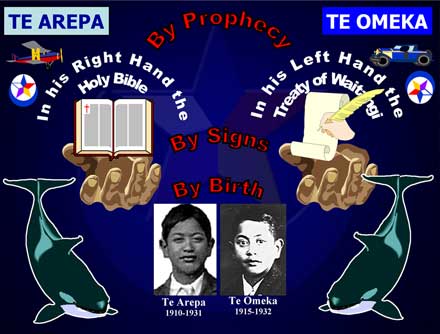
The second whale, although it never died (oral history) represents the physical work (Ture Tangata) the work of Piri Wiri Tua dealing with the Tiriti O Waitangi, the rights and the privileges of the Maori people as embodied in the Tiriti O Waitangi, and other aspects dealing with the material things of the world, as we still await the works of the second whale and the prophecy to be fulfilled.
The interpretation of the two whales, explain in the Rongo Pai Hou A T.W.R.Mangai, and Book One of the Akoranga suggest that Satan himself allowed these creatures to come ashore, to signify to the Maori people he has with drawn his yoke from them to signify they were now in the palm of Jehovah’s hand. Some Maori historians suggest that these creatures help guide the canoes of our ancestors who migrated from Hawaiki Nui, Hawaiki Roa, Hawaiki Pamamao, on the ripples of Te-Moana-Nui-A-Kiwa to Aotearoa. It is said that it was a Taniwha that brought the Maori here to Aotearoa! When our ancestors arrived here to Aotearoa; these two whales had returned to fulfil the prophecy. (Te Rongo Pai Hou, Sheet 6, Volume One 1930-40; Akoranga Anaru, 1997: pg54)
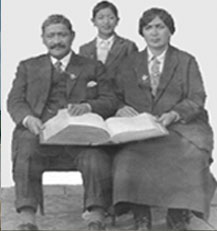 |
On the 29th March 1918, at the Ratana homestead, Wiremu and Urumanao were going about with their daily chores, with both boys playing and running around the homestead. Suddenly the sound of a child crying echoed through the house, both parents rushed to the aid of their crying son. Arepa took hold of his younger brothers hand lead him to their parents. His injuries had caused blood to flow from his knee. Wiremu and Urumanao began to attend to their son’s injury caused by a needle piecing his knee. Both parents began to pray in earnest for their young sons recovery. Wiremu was man who had great faith in God and his Heavenly Host. |
|
|
They prayed continuously for several days; this was the first time Wiremu uttered the name of Jehovah, Matua, Tama, Wairua Tapu me nga Anahera Pono. Few days later, they decided to take their son to the doctor in Wanganui. The doctor examined their son and found a needle had pieced his knee. He proceeded to attend to his injury finally wrapping his knee with a bandage. That evening back at the Ratana homestead, peace once again reigned, the boy began to recover from his injury. Once Omeka regained his strength Wiremu returned to his old ways going back to the local down Turakina with his friends indulging in the material things of world. That evening Omeka fell ill, and on his fathers arrival home the boy was rolling around, groaning and crying continuously. (Akoranga Anaru, 1997: pp54-55) |
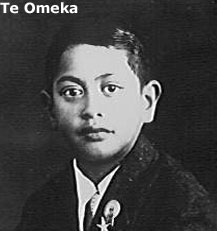 |
Several days later, they decided to take their son back to Hospital. On arrival, the doctor checked out the boy and said to take him home, if he does not recover after two-days return him back to my clinic. Wiremu agitated by the doctor’s request, argued with the doctor saying their son would die if nothing were done, but eventually he agreed with the doctor and they travelled back to the Orakeinui. That evening Omeka health deteriorated with his infliction he rapidly was on the verge of dying. Wiremu could feel a great sensation coming over him. There and then he said, now we have our son back home we shall pray for the spiritual doctors to heal our son.” (Kara Book, Pene: 1990) (Akoranga, Anaru, 1997: pp54-55) |
The Vision 1918 |
The Visitation 8th November 1918 |
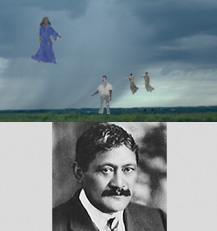 |
On the morning of the 8th day of November 1918, three days before the end of the First World War, Wiremu Ratana felt as if he were on fire he had become agitated and restless. Around one o’clock that afternoon he could not relax and was constantly in and out of the family homestead. Wiremu went out on to the verandah, facing the railway station; he began to pray for his son Omeka, who was still seriously ill. He told his wife, that the spiritual doctors would be here to heal their son. Wiremu began to drift into a deep meditative state of thought as he leaned on the verandah post looking out towards the sea. The time was around two o'clock when this great event took place that would transform the direction of Wiremu Ratana’ life. |
|
|
This phenomena would ripple throughout Maoridom and eventually the world. Wiremu noticed a cloud formation hovering and moving above the sea heading in his direction. It rose high above the sand hills and came through Waipu Lake, and stopped over the top of the old Ratana railway station for a short moment The began to move slowly in its entire wrath and power witness only by the chosen few men of God; this anointing was bout to empower a humble farmer. The cloud coasted slowly towards Wiremu its appearance on the outside was dark, the centre flickered in white and the rear of the cloud was a blaze of fire. |
Wiremu was paralyzed with fear at what was occurring before his eyes. This was so unbelievable to Wiremu he thought this was judgment day for mankind, as he turned to go inside to be with his family on approaching the door to enter the house, the cloud exploded and from it's centre a ray of sunlight beamed through, he fell to the ground as though falling continuously. It was during this time that he heard and saw visions of the future as the Holy Spirit began speaking to him. He was so overwhelmed he could see all the paths and roadways of the world, leading towards Ratana which in later years would be known as the Pa O Nga Ariki. (Editor WM Te Tai: 1924, Henderson, 1963: pp24-25; Kara Book Pene K: 1990) Kia Tau Ano Te Rangimarie: Kaua Hei Wehi, Ko Ahau Tenei Te Wairua Tapu. Kua Raunatia e Ahau Te Ao Ki Te Rapa Turangawaewae Moke. Be at peace, fear not, I am the Holy Spirit. I have travelled around the world to find the people upon whom I can stand upright. Kitea Mai E Ahau Kei Aotearoa Nei Ko Koe Ko Te Iwi Maori; Ripeneta! Horoia Koe Me To Whanau Kia Ma Me Tehukarere Kia Harakore Me Te Kukupa". I have come back to Aotearoa to choose you, the Maori people. Repent! Cleanse yourself and your family as white as snow as sinless as the wood-Pidgeon". E Ratana, Kua Meatia Koe Hei Mangai Moku Ki Te Mata O Te Whenua. Whakakotahitia Te Iwi Maori Ki Raro Ki A Ihoa O Nga Mano He Aroha Hoki Tenei Na Ihoa Ki A Koutou. Ratana, I appoint you as the mouthpiece of God for the Multitudes of this land. Unite the Maori People, turning them to Jehovah of Host, for This Is his compassion to you all.
Wiremu said to his wife that the spiritual doctors are here now to heal their son. He was made to see everything in his body, the roots from whence all illnesses and sicknesses stemmed. As Wiremu was speaking loudly a friend of the family Mrs Pito Reremoana, jumped up and started to wave a potato in front of Wiremu in an attempt to ward off Maori Atua (demons), she thought Wiremu was possessed. Wiremu’s daughter Te Reo was standing at the door and she returned a short time later with the bible in her hand. She gave it to her father in the hope it would help heal him of his sickness. But, when she looked into his eyes, it was like his eyes were on fire when a strong voice sounded from out of his mouth saying. "Don't you know girly I wrote this book". Wiremu overcome by the Holy Spirit threw the bible across the room. Wiremu took hold of his grandfather’s clock and throw it at the wall breaking it into many pieces. There was a Pakeha man who worked for Wiremu. Wiremu said to the man if you wish that this clock should ring at 5 o’clock it shall ring at 5 o’clock. Before he broke the clock the time was 2.30. Wiremu then threw the pieces of the clock into the stove. The Pakeha man immediately went forward to retrieve pieces of the clock. The clock rang on the fifth hour. When Wiremu finished speaking his family questioned him on what he had said? Wiremu could not answer them, so he went to his study to reflect what had taken place. He remained in his study room for a number of hours. His daughters Reo and Piki were in the room at the time of the incident when there appeared reflection in the mirror that caught Wiremu’s attention. He turned around to find the Arch Angel Gabriel standing in front of the window in great splendor before him, Gabriel repeated what the Wairua Tapu had said that day, instantly the wisdom and knowledge began to flow from his mouth he then remember all that had taken place that day. (Akoranga Anaru, 1997: pg55-56; Kara Book Pene k: 1990) |
The Testing
The Wairua Tapu began to teach Wiremu all the mysteries of the Heavens and the Earth, the purpose of all creation, their infirmities, and their remedies. Wiremu was taken out of my body in the spirit, and made to look back upon it, so that he might see and understand the workings of the body. The Holy Spirit taught him that the body was like a transistor radio with many different parts. If any parts of the radio was damaged the radio would not work properly, and that all he had to do was to repair the broken part. (Rongo Pai Hou, Sheet 8-9 Vol1, 1930-40; Akoranga Anaru, 1997: pp56-57)
 |
He was taken to the heights of the Heavens to look onto the "Hara" (sickness) of Aotearoa, Wiremu was also taken by the Wairua Tapu and shown the four corners of the World and the people who dwelt upon it. The Holy Spirit showed visions of the future, of pathways from all over the world leading to this Pa. The Angels Michael and Gabriel and the works that they would undertake on our behalf, and a Movement made up of mixed denominations, all coming under the power and will of the One True God and the Son of Man. The Holy Spirit finished teaching him, it felt like hours had past by but in fact this had all taken place with in a matter of minutes. Wiremu was lead to a tobacco plantation, a question was asked by the Holy Spirit: |
|
Wiremu’s wife had great love for her husband and she turned to challenge the Holy Spirit.
“If this is the Holy Spirit that is making Wiremu work I shall be patient, if you are not the Holy Spirit, I shall not agree that you remain here.”
“The Holy Spirit then spoke to “Urumanao”!
You shall be known as Woman among woman, you shall be known as a Mother, “Whaea.” “This is the Holy Spirit speaking unto you. I shall make this place a great Pa, a beautiful Pa, where the customs and habits of the Islands shall be brought here,and indeed those oftheworld.”
Autobiography of Tahupotiki Wiremu Ratana: explains during his testing by the Holy Spirit, he was approached on several occasions by the Angel Gabriel, initially stating his credentials as head or president of the angels or messengers from the Throne of God to man, announcing the angels would be his helpers.
“All the while that I was tested, tried by the Holy Spirit, it was the Angel Gabriel that made it known to me of the plans that the Holy Spirit had for me, and the replies of any question that maybe forth coming. For two weeks, T.W.Ratana was judged, investigated for his sins. He was mad to work, going day and night through rain; wind, with no sleep “nor” kai. He was put through barbwire fences, thorn bushes. His body was intensively violated, torn and ripped by the barbwire and thorn bushes. After his testing he was ready for his mission that was preordained by the Wairua Tapu”.
“Wiremu, this is I Gabriel, the head, President of the exceedingly great number of Angels, my position, place is before the Throne of God. We are the Angels the messengers from the Throne of God to Man”.
“Wiremu, we the Angels from the time that the world began, we were not known by the world, up to this very day.” We are hoping that you stand in the place, position that the Holy Spirit has in mind for you, so that we the Angels, through you shall be my known to the world. There is one thing, if the Holy Spirit asks, how is that you know, the replies, let our name be absent from you”.
“After this, you shall be made to die, be brave do not be afraid, we shall be your companion and assist you. The Holy Spirit shall make you die. The Holy Spirit revealed to him all the biological parts of the body of man, the illnesses and the cures, and the medicine for such illnesses”.
“Appeared to T.W.Ratana after the Holy Spirit had departed and spoke to him and said there will be one more test for you. You will be made drunk, when that time comes, be patient, be brave and strong, there is only one thing, do not utter swearwords or curses from your mouth”.
“Speaking to T.W.Ratana, you have succeeded in the test given by the Holy Spirit. We the Holy and Faithful Angels Rejoice, for you have had patience and courage, and strength. We shall be your friend and helper at all times. There shall be one more test for you to complete, the Holy Spirit is deliberating as to whether you shall be Holy or just an ordinary man. When the Holy Spirit questions you! You shall say, what ever you desire O Lord”.
“Wiremu I have been deliberating whether to make you a Holy Person or just a ordinary man; “Wiremu replied) whatever you so desire LORD. The Holy Spirit replied, So Be It, you shall remain an ordinary man. Tohungaism, Prophets, Intellectuals will not rise in your presence. You shall destroy all things evil that may never over come you. The last advise, go forth and remain Humble”.(Akoranga, 1997: pg5)
Wiremu Ratana suffered tremendous testing upon his physical body the trials he was forced to undertake looking at his true nature as a man all the sins, he committed, and to repent in preparation for his work as a travelling evangelist.
The Angel Gabriel supported Wiremu right through his trials and test. After his testing, he was ready for his mission that was preordained by the Holy Spirit. (Akoranga Anaru, 1997: pp56-58)
According to the late Te Reo Hura, Wiremu Ratana's daughter, she witness the events that took place leading up of the 8th November 1918, her father was judged for two weeks and severely tested by the Holy Spirit and even tempted by the devil to curse God. It is alleged he went without food or sleep for two weeks during his testing requiring him to understand about man's weaknesses, the remedies and about creation and life. After the testing, he was found obedient and strong enough in mind and spirit to preach the Maramatanga to his Maori people, then the World.
There are many conflicting stories on the actual events that took place changing the path of Tahupotiki Wiremu Ratana’s life, however, Te Reo Hura and her sister Piki; they were present when these phenomenal events took place, along with their brothers Arepa and Omeka. Every night before Wiremu and his son Arepa would leave the house to go on his nightly mission, Wiremu would call his family together, through some divine intervention Urumanao and their children were put into a deep form of sleep hypnosis. Although Ratana’s son Arepa was present with his father holding a candle, he never faltered or was discouraged being there during the testing through the night until the early hours of the morning. When they returned that morning Ratana would sometimes be covered with cuts and bruises and bleeding. (Oral history 1988)
In 1947, a young man from Pamapuria in the far north arrived at Ratana pa, his name James McLeod Henderson. He had the privilege to interview many of the old people who worked and lived in the Pa during the early period of Ratana’s ministry of the Movement and Church. This opportunity allowed him to speak with the Reverend A.J.Seamer; he became a personal friend of Puhi O Aotea Ratahi, (Tumuaki/President), Sir Eruera Tirikatene (MP), John Motu, Tangi Te Pere and Mick Hogan and many other Morehu.
Mr. Jim Henderson, is the Author of the book Ratana the Man, the Church, the Political Movement, had interviewed many Kaumatua and kuia. He was told during the summer of 1918-19 Ratana went through a whakamatau tauranga a time of testing during which he roamed the old ancient seabed plateau where the Ratana farm was located. Although certain leaders and individuals of the Ratana Church questioned his book and the content written therein, we believe that many adherents of the Ratana Church as well as other interested parties gained a better insight into the Church through reading his book. (Letters J.Mc Henderson 10/3/94)
The publications of the (1924, Te Whetu Marama o te Kotahitanga) the chronicles of the Ratana Movement and Church, the (Te Rongo Pai Hou A T.W.Ratana Mangai) the set of (Nga Akoranga) portrays its views on the events leading up and after the 8th November 1918, how Ratana was tested by the Holy Spirit to develop his new character and to strengthen his faith. Although tested to the limits that of his physical being, any normal man would have surely perished. The history elaborates that Ratana would run and jump over barbed wire fences and gorse and blackberry bushes to prove his obedience to the tasks that lay ahead of him to remind him he must fear no one except God the Father.
Although, he failed many times, he was comforted by the presence of the Arch Angels Gabriel and Michael who supported him during his trails, he still received deep cuts and bruises to his body, bleeding when he returned home to the farm. Rev Piri Munro a friend of Wiremu Ratana in a personal interview in 1921, explained that Ratana went through a great change emotionally and spiritually during his testing crashing through fences and other obstacles not allow any person to come near him. Some member of his family arranged for him to be sent to a mental hospital in Porirua, which never happened. (Te Rongo Pai Hou, Sheet No.37 Volume One, 1930-40)
Te Whaea O Te Katoa (The Mother of All)
The Gift from Holy Spirit tested Urumanao Ratana's loyalty to Jehovah, through her entire life in supporting her husbands twenty year ministry proclaiming and preaching the Maramatanga. During the "Whakamatautauranga" (period of Testing) T.W.Ratana endured, Te Urumanao was there; she saw and heard most of what took place. There were times when T.W.Ratana, himself, could not fully remember what the Holy Spirit had said, or instructed him to do. In such cases it fell to Te Urumanao to tell him and so refresh his memory and make him clear as to what he should do. More often than not they discussed their matters together.
.jpg)
Urumano and her children were made to suffer great hardships and fears during this period, having little to wear and virtually nothing to eat, and having also to prove their Faith and Loyalty. On one occasion during the Testing: - Te Urumanao was in tears standing on the porch of Orakeinui, as she looked at her husband standing naked between the whale bone archway at the front of there house bleeding from the failure to pass the test given by the Holy Spirit. She ran inside to get a blanket to cover him and keep him warm, as she came towards him, the "Holy Spirit" appeared before her and said "If you torch this man you will die " it was at this stage that the Maramatanga really started to unfold, she was full of love and compassion for her husband, not concerned with the warning she moved passed the Holy Spirit and comforted her husband.
The Holy Spirit responded to this act of faith by saying "Are you willing to support and be loyal to me and my work?"
Her reply "If you are the Holy Spirit which we know and worship, then I will be loyal to you; but if you are a False Spirit I shall denounce you"
The Holy Spirit knew her heart was pure and said "I am satisfied with your faith and strength, i see that you will be a Woman among all Woman; Jehovah has decided that from this day forth you shall be known as "Te Whaea o te Katoa"
Te Whaea ote Katoa was a humble and kindly woman, and yet she seemed to radiate a feeling, or spirit of loyalty and strength. Before the Church was registered in 1925, Te Whaea ote Katoa was head of a group known as Te Roopu Neehi (The Nursing Group) of course, we know them today as Nga Awhina (The Sisters of Mercy) her personal tohu become the emblem used on the head-wear of all our present day Awhina.
1. Te Kupu A To Matua -E Toko, Haria Nga Mahi. (Ture Wairua me te Ture Tangata) Your father words "Toko", you must carry on with the work, Ture Wairua and Ture Tangata.”
2. Tuarua O Nga Kupu A To Matua Kia Koe. "Kia U ki te kaupapa, Matua, Tama, Wairua Tapu, me nga Anahera Pono, me Te Mangai. Kei konei ahau e tu ana". Secondly "Be loyal to the Kaupapa, Father, Son, Holy Spirit and Faithful Angels and the Mouthpiece.”
Te Arepa (Tommy)
This name comes from the Greek word Alpha, which means "The First "
or the "Beginning.” He was given his name by Ngahina Ratana
and blessed by Mere Rikiriki. and was baptized by Iwiora Tamaiparea. Because
his name was Tapu (Blessed) and was in danger of being abused, Ratana
made everybody call Arepa by his nick name (Tommy) who was born 1910.
Te Omeka (Joe Mick)
This name comes from the Greek word Omega, which means "The Last"
or "The End.” Because his name was Tapu and was in
danger of being abused, Ratana made everybody call Omeka by his nick name
(Joe Mick) who was born 1916.
Te Reo Hapai I Te Himene e Ihu e Te Kinginui
(The Sweet Sound of the Hymn Jesus the King) This name was given to Martha
by her father on Mount Taranaki at the site called Te Rere o Kapuni. She
was to sing this song with her mother to Ratana many times, it was his
favorite Hymn. At a Hui Whakapumau in 1969, Te Reo said "E nga Morehu
e kore ahau e hoki mai na runga ite whakahokitanga mai ite ingoa i tohungia
ai e te Mangai, ko Te Reo Hapai Ite Himene E Ihu Ete Kinginui ite Tau
25th of Dec 1918". Her term as Tumuaki would last 24 years seeing
the years in which the Movement had a total face life
Ministry of T.W.Ratana (Mangai, Piri Wiri Tua)
During the early period of 1918-1919, south of the Whanganui district is a small settlement between Whangaehu and Turakina is a little settlement called Ratana Pa. This homestead is set in the midst of a farm and the dwelling place of Tahupotiki Wiremu Ratana a Maori ploughman. This man was empowered with the gift to heal and preach the gospel of God, this great revelation given to him on the 8th November 1918. However, he was put through many tests to see if he would be capable of carrying out the work set aside by the Holy Spirit. He completed these test towards the end of November, then rested for a few weeks. (Henderson J: 1963; Te Rongo Pai Hou Sheet No.37: 1930-40)
(Ratana The Maori Miracle Man By Rongo Mai, Henry Hector Bolitho: 1921)
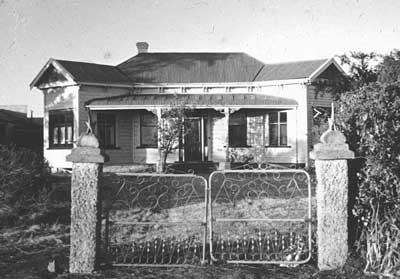
During Christmas his family were gathered together, he told them that the Holy Spirit had anointed him to go preach and heal the sick in the name of the Father, Son, Holy Spirit, and their Faithful Angels. The Holy Spirit had bestowed upon him the anointed name Mangai, (Divine Mouthpiece between God and Man). Those who follow him would be called Morehu (Remnants).
Ratana was a man of great spiritual faith, who believed in the power of prayer and was to become the greatest spiritual leader that has ever moved amongst the Maori people. The Holy Spirit came to Ratana when the whole world was in a period of global war between 1914-1918. Three days after the 8th November the 11th November 1918, peace was declared through out the world. The Holy Spirit empowered Wiremu Ratana with the gift of evangelism allowing him to go forth and preach the word of God (1919-1939). He carried the Holy Bible in his right hand and the Treaty of Waitangi in his left hand as his vehicle through his twenty-year ministry spreading aboard this great revelation. His mission was to unite the Maori people, turning them from their old beliefs in evil spirits; tohungaism, black magic and jealous leading them back to the one true God. (Akoranga Anaru, 1997: pp52/57)
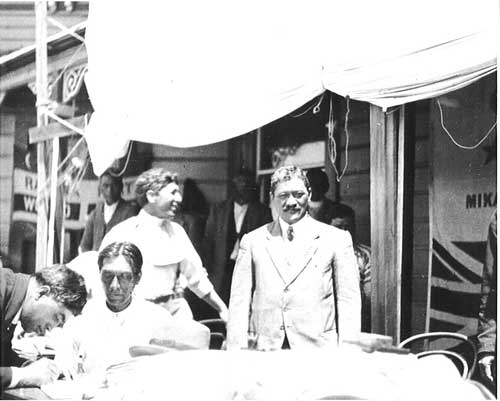
(Maori Version)
"Haere kauhautia te Rongopai ki to Iwi Maori, whakaorangia ratou i o ratou mauiui i runga i te Ingoa o Te Matua, Te Tama, Te Wairua Tapu, me nga Anahera Pono; i tenei ra ka huaina koe he Mangai, ko te hunga e aru i a koe ka karangatia he Morehu.
(English Translation)
“Go forth, spread the Good News among your Maori people, heal them of their infirmities in the name of the Father, the Son, the Holy Spirit and the Faithful Angels, this day you shall be called Mouthpiece, and the people who follow you will be known as Remnants.” (Henderson, 1963: pg25)
In the early stages of 1919, his work consisted in the preparation to unite the Maori people and spread abroad this new enlightenment and ministry. Although the first recorded healing by Tahupotiki Wiremu Ratana was his own son Omeka, who was seriously ill with blood poisoning, in those days’ doctors had no access to antibiotics, compared to what drugs and prescription we have today. In the healing of his son Omeka, Ratana was able to cure his son through acceptance in God Almighty that enabled him to perform his first miracle in total faith.
Ratana favoured no one Church but rather embraced them all. The main work and activities during the end of 1918, and the beginning of 1919, consisted of preparation for his ministry in the Ture Wairua (spiritual works) as a travelling Evangelist preaching the good word and delivering divine healings. Maori society had always had firm religious overtones, although many Maori were still recovering from the First World War and from the great World Epidemic of Influenza known as ‘the Spanish Lady’ which laid the country low and caused rife in the Maori population. This was evident that the conditions were ripe for a spiritual and religious awakening among the Maori people that set a path for Ratana to preach his message, as thousands flocked to him for enlightenment for their spiritual and physical welfare as the Ratana ministry began to spread throughout the country. It was obvious that people from near and far began to clamour after Ratana and his divine ministry because of conflicting and inconsistent statements and doctrines of many churches, by 1920, Ratana Pa was opened to all tribes and all religions.
(Editor WM No.1867, January 1981: pg6; King M: 1988)
1) This mantle was thrust upon him by the Holy Spirit
2) He also was a member of the working class people.
(Cox.L, 1993: pg117)

Introduction of Symbols
(Patu) (Six Pointed Star)
In 1919, Ratana introduced the Patu was introduced, (Maori hand weapon) symbolic for status the power and authority, in old Maori customs and traditions. During important Hui or Tangi Maori would lay their Mere, Taiaha, Korowai, Hae Tiki, and Patu in front of the Marae. This showed visitors their prestige in hieraracy of the individual.
In this case, T.W.Ratana was severely tested by the Holy Spirit the mighty Hand of God. He would be molded like iron in a furnace, hammered, and crafted into shape prepared for his mission. This manifestation was called Whakamatautauranga (Period of testing) in which T.W.Ratana the man was turned into an invisible weapon of God, strong and unshakable symbolic of a (Patu) because of his faith in Jehovah of the Multitude.
T.W.R Mangai wore the six-pointed star commonly referred to as “The Star of David” at the very early stages of his ministry. “(Te Pakiaka Te Uri o Rawiri, Te Whetu Marama o Te Ata)” The Root of David, the descendants of the Bright and Morning Star.” T.W.Ratana was directed by his Kuia Mererikiriki Ropia to follow the God of his ancestors Abraham, Isaac and Jacob. The six-pointed Star of David represented all the Laws (Tora) and traditions of ancient Israel. This emblem carried for the Israelites a tangible quality of holiness that set them apart as the Children of God in the time of the Old Testament.
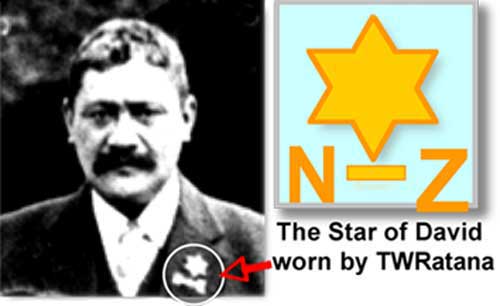
The Whetu Marama o te Kotahitanga, Ratana Registered Newspaper printed 29th March 1924, shows (Te Pakiaka) is mentioned twice in the (WM No.193, 3/12/27). The editor changed the opening prayer to include
“He mea ano hoki e hiko ai te mahara ki roto I o ratou whatumanawa ko Koe e Te Mangai “Te Pakiaka me te Uri o Rawiri me te Whetu Marama o te Ata”. Today we see in Te Whetu Marama o te Kotahitanga"
“Ko Koe Te Mangai Te Pakiaka Te Uri O Ratana Te Whetu Marama O Te Ata, A Ko Koe Ano Hoki E Te Mangai Te Whetu Marama O Te Haahi Ratana, Me Te Whetu Marama O Te Tiriti O Waitangi”.
(1920) Rosette
In 1920, the Rosette pendent emblem was used by the T.W.Ratana comprising of three colours. These colours are used to signify the Holy Trinity (Toko Toru Tapu). The centre circle and middle ray is blue representing the Father. The middle circle and ray to the right is white representing the Son of God and the outer circle and ray to the left is red representing the Holy Spirit. Ratana introduced this Symbol in 1920, to help his followers
understand his new colour Scheme. These colours were used throughout his
ministry to depict different aspects of the New Teachings, for example
the Rosette introduced the “Toko-Toru-Tapu” (Holy Trinity), which was in common use by most of the Christian Churches of that time.
I te Tau 1920, ka puta ko te Tohu o te Rosetta “Ko tenei Tohu, e toru nga Kara, he Puruu, ko te Matua tena, he Ma ko te Tama tena, he Whero, ko te Wairua Tapu tena
Age of the Miracles
Maori and Pakeha a like were reading the stories of T.W.Ratana Mangai and his many cures how people inflicted with various aliments were being treated. When healing children it was on the parents to express their faith on behalf of the child. Ratana would ask the patient their name, followed by, what is their sickness? The person would reply, and Ratana would look at the person with his piercing eyes that penetrate your inner most being, which was one of his distinctive features. He would ask;
“Do you believe in God” with the person replying “Yes” he would then ask, “Do you believe there is only one God; then the power of your faith will heal you of your infirmities.”
If the patient had true faith, they would be healed of all the infirmities. At all times these patients requesting help were asked that they make a solemn promise in the future they would put their faith in almighty God. Even at that, early stage of his ministry people began to trek to what was popularly called the “Pa O Nga Ariki” or Ratana Pa to be apart of this great miraculous revelation. (Editor WM, Te Tai: 1924; Elsmore B, 1989: pg343)
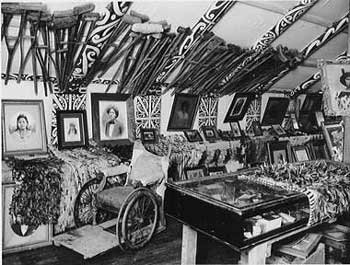
Ratana’s patients after having been healed of their ailments renounced their old beliefs and tribal identities and pledged themselves under the mantle of Jehovah, becoming members of the ever-growing Ratana ministry.
(Cox.L, 1993: pg118)
The New Zealand newspaper reporters and photographers all wanted to interview Mr Ratana but he wasn’t a man who believed in the limelight. Even so they dubbed him as the “Maori Miracle Man” who said, “Through believing faith in God you can be cured.”
Requests for divine spiritual healing were sent from as far as Australia, England, America, and many other countries. Ratana replied to all these letters urging them to pray in faith and keep firm in their belief in the one true God and that the power of being healed laid in that foundation. “Through faith, all things are possible” and that they would be cured. (Editor WM, 1997: pg5)

Ratana Pa Religious Sanctuary
Many Maori began moving to Ratana Pa, transforming this once quiet farm into a densely populated shantytown. Large marque, small tents and huts were being built. Electricity was installed and Ratana Pa became the setting of a religious village. Food such as bullocks, sheep, vegetables, seafood as well as fresh drinking water was being transported into Ratana to cater for the thousands. By November 1920, the pilgrimage of Maori to Ratana Pa was well established. Mr Ratana was able to inspire the Maori people with his faith healing miracles and deep religious belief in Christianity the inspiration of his divinely given healing powers. This practice convinced Maori that their old pagan ways in Tohungaism was a sin in the eyes of God. The Maori people were encouraged to stay away from those old practices and to worship the one true God of heaven and earth. Some Maori who were not convinced with Ratana’s Christian teachings began stepping back into their old practices in Tohungaism and Makutu.
(Te Rongo Pai Hou A T.W.Ratana Mangai: 1930-40)

The Original Meetinghouse in Ratana
During the early period of 1920, there were four
original large meetinghouses and a double cabled cooking and dinning facility
they all served a purpose, each representing a significant cause. From
the west to the east, their names were Te Aroha, Rangimarie, Whare Marama,
Piki Te Kaha, and Kii Koopu. The Kii Koopu was used to feed the people
and during the evenings it would be used for evening dances and fun raising
events.
The Piki Te Kaha was used as a sleeping facility for visitors and was used as the place where young people were taught in the skills of Taiaha, Patu, and Maori Martial arts along with the good aspects of Maori Culture. Te Aroha room was used as a sleeping facility before the original Manuao was built. Te Aroha was also used by the Reo (Band) for practice and rehearsals. This building was also used during the pre-Manuao times as a schoolroom for the children. This room is where T.W.Ratana passed away on the 18th September 1939, at 10am Monday morning. Te Whare Marama was used as a hospital with up to 30 to 40 beds in the facility. The Awhina (sisters) were qualified, as nurses became staff for the patients. The Rangimarie was used for political purposes where discussions were tabled concerning the welfare for the Maori people. Their representatives in Ratana would represent the Maori people of the land in Parliament. T.W.Ratana was the overseer of all works.
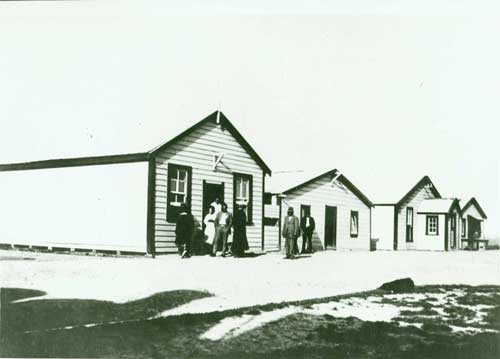
(1921) South Island Tour
During July and August 1921, T.W.Ratana Mangai and his Roopu (party) toured south, his mission to heal the sick and infirm; breaking down the power of ancient superstition that was rife amongst the Maori people. T.W.Ratana Mangai on the contrary taught all who came to him that these forces were evil and came from the devil and his hosts. He told Maori people that they must heed such forces, believe in the power of the Holy Trinity and the Holy Angels. This was very difficult for Pakeha to understand what it meant to Maori to declare what he had believed to be the spirits of their ancestors were really the emissaries of the devil. The old believes and principals of (Tapu and Noa) had no place in Maori society with the introduction of Western medicine growing influx and influences of the missionaries during the early 1800s, who had railed against the old polytheistic belief systems and healing practices that Maori were utilizing. (Otago Witness May 31st 1927: pg50)
T.W.Ratana Mangai saved thousands of lives by his campaign against tohungaism in various parts of New Zealand. Maori remained very near to the spirit world and were strongly affected by spiritual forces good and bad. These spiritual forces were believed by some Maori to be the spirits of their ancestors and friends. Ratana announced his message to the Maori people to unite as one under the mantle of Ihoa o nga Mano, (God of the Multitudes). His message would always remain the same, kotahi kotahi, kotahi, (unite, unite, unite). T.W.R Mangai has undoubtedly had a great success and has done more to free the Maori mind from tohungaism than any other man, Maori or Pakeha has ever done. He set out to demonstrate faith in the one true God, could do more good than any potent spells of the greatest Tohunga and the introduction of western medicine. Ratana’s patients after having been healed of their ailments renounced their old beliefs and tribal identities and pledged themselves under the mantle of Jehovah, becoming Morehu (Remnants) of the ever-growing Ratana ministry. Ratana was able to demonstrate the power of faith through his healing for the body and spirit believing in the one true God. He always encouraged Maori to reject the evil ways of the old tohunga’s and their practices worshipping false Gods and idol worship. (Editor WM, Te Tai; 1925: pg2)
A telegram was received at Rapaki late on Friday afternoon stated that T.W.Ratana would arrive on Saturday morning. On Saturday morning, there was a great deal of secrecy about Ratana the Maori faith healer. Ratana and his group arrived at Lyttelton by the ferry steamer Maori. Word was sent to other Maori communities at Kaiapoi and Little River where large number of Maori gathered at the Lyttelton wharf who were trying to pick Ratana out from his travelling party of supporters. The rumours of Ratana’s arrival had spread through out the community and those who did see him, knew it was Ratana because of his distinguish looks and his strong piecing eyes that look right through you most inner being, as he is a most elusive person. Although most of the crowd were trying to pick him out, through some uncanny way Ratana was able to walk quietly leading his son by the hand, walked down the gangway and off the wharf to the vehicle avoiding conversation as much as possible.
Ratana’s private secretary Pita Moko explained that Ratana does not give interviews. He went on to say that, Ratana would not personally treat Pakeha, and would not treat Maori in the presence of Pakeha, and he healed Pakeha by correspondence. One member from the press asked what Ratana intended to do in the South Island. Mr Moko replied that he would be at Rapaki until Monday, but beyond this, he would say nothing. Ratana’s party consisted of twenty-two people including his wife Urumanao, and the wife’s of other leaders and members of his staff. There would be a large number of Maori expected so special arrangements had to be made, Friday night and Saturday morning where food and large quantities of meat and vegetables and bread were being prepared. There was a large amount of Kai Moana collected sacks full of large mussels were gathered. A cookhouse of iron was erected, and loads of firewood taken in. The meeting hall was prepared with straw and bedding for visitors to sleep in and everything was in readiness by the time Ratana and his party arrived Saturday morning.
(Nelson Evening Mail August 10th 1921; Editor WM, July-August 1967: pg7)
After departing from the wharf Ratana and his party travelled by car to Rapaki, with the overflow being accommodated in spring carts. They were given a proper Maori welcomed on Rapaki where Ratana and his party formed two ranks and marched slowly down the hill, preceded by Ratana’s flag which bears on it in Maori and English quotations from Scriptures, and a Union Jack surmounted by a crescent moon and star in one corner. A party of young Maori women, who waved green boughs and sang the tuneful “Haere Mai” song of welcome, greeted them. At the entry of the Meeting hall the party came to a halt while one of the woman recited waiata in Maori. It was also noticed that the men had kept their hats on during the ceremony of welcome. At Rapaki Hall Ratana and his party were welcomed by the Kaumatua (Elder) Honi Taare Tikao. Saturday afternoon was taken up with the reception ceremony, both of Ratana and his party, and to the local visiting Maori. After the formal ceremony of welcome, the whole party then entered the Rapaki hall.
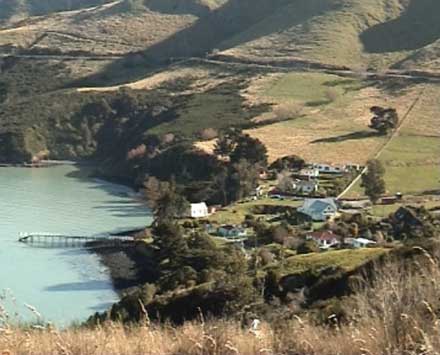
Both Maori and Pakeha who gathered came from as far as Dunedin, there were many from Kaiapoi and little River, Port Levy, and also Banks Peninsula. On Saturday, evening church service was conducted in the Rapaki Hall. There was an old Kuia with snowy white hair, she did not her own age, but believed she was in her nineteenth year, who made the trip with other Maori from Port Levy. At Rapaki, she sat there smoking her pipe, speaking to other Kaumatua and Kuia and conversing in Maori and English. Honi Taare Tikao was the first person in the South Island to be healed he suffered with gout and rheumatism for many years; On Sunday, after T.W.Ratana Mangai delivered divine healing upon him he told Mr Tikao to go to his house and go to bed to rest his body, Ratana told him that we will have to wake you up in the morning and pull you out of your bed. Mr Taare Tikao had slept soundly and had to be wakened just what Ratana told him so he could catch the train with him and his party. Mr Tikao had suffered for forty years with his illness and due to his healing; he was able to under take the trip to Temuka with Ratana and his touring party. (Nelson Evening Mail August 10th 1921; Editor WM, July August 1967: pg7)
There were a variety of illness treated at Rapaki by T.W.Ratana Mangai that ranged from indigestion and rheumatism to blindness and other physical ailments of the mind and body. Several babies and young children were bought forward for healing. There was one blind woman who was told she would be healed in one week. Through prayer, T.W.Ratana Mangai was able to heal the individual and long as the patient had total faith in God All Mighty, they would be healed. As far as Ratana could gather he spoke on the same lines at all the Marae he visited advising his hearers to serve and believe in the one true God. However, like always Ratana would ask his patient the nature and details of their illness. Mr Paki Hami was the first person from the Chatham Islands to be healed due too an accident where he suffered from two broken ribs and a back spine injury had four operations spending seven months in Christchurch hospital, he suffered a great deal of pain and had problems of standing upright. Mr Hami heard that T.W.Ratana would be visiting the South Island and visited Ratana at Rapaki for divine healing.
(Temuka Leader 23rd July 1921; Editor WM, July August 1967: pp9-10)
Another case is a Maori woman in her early fifties, Maria Kini who resides at Little River who had been blind almost her entire life. On Sunday night T.W.Ratana Mangai talked with Maria Kini, he explained to her how he would administer his divine healing upon her. The Mangai then placed his hat over her eyes, and ask her “can you see anything” Maria replied no, it is still all-dark. The Mangai then remove his hat away from her eyes and led her to the window, where the rays of the sun were streaming in and asked if she could see anything. After several minutes, she turned around to him and said yes I see some light, and eventually her eyesight was restored back to full sight. After leaving, Rapaki Ratana and his party travel in a reserved carriage by the second express. Once they arrived at the Railway station Ratana decided to take his young son for a walk up Manchester Street, where a large group of people gathered at the railway station for a sight of the Maori Faith Healer and were having a great difficulty identifying whom Ratana was. After a while, he returned to the station where he boarded his private carriage and was spotted removing his topcoat, and then he disappeared. As the train began to leave Ratana suddenly appeared on the rear platform of the carriage out of thin air smiling to the onlookers as he lifted his top hat to his spectators, as the train moved off. Many of the onlookers were left in disbelief as they pondered how did he appear out of thin air and did he possess other supernatural powers in addition to his Divine healing gift. (Rongo Pai Hou A T.W.Ratana Mangai Sheet No.38-39)
(Nelson Evening Mail August 10th 1921; Editor WM, July August 1967: pp8-9)
On Monday 25th July 1921, Ratana and his group left Rapaki travelling by train to Temuka. At the station, eight cars were waiting to pick Ratana and his party to transport them to the Arowhenua Hall, Te Hapa a Nui Tireni, which stands, on Hipa Te Maiharoa land. There were a large number of people gathered at the Arowhenua hall, from around the district amongst the visitors was Rev. Te Muera (Otaki), and Hakaraia (Taranaki). C.Te Kao from Whanganui, with Mr Tikao from Rapaki. The congregation left the motorcars at the bottom of the hill formed a procession headed by the Ratana Flag carried by his son, as the woman began to Karanga, with replies from 20 women on the roadside of the Pa entrance. On entering the gates of the Pa, the visitors processed to the east gate and were welcome by the Paipai (speakers of the Marae), Hemione Torepe, James Cooper, T.Karetai, H.Maire, J.Pohio and Mr H.W.Uru MP for Southern Maori Constituency. In reply, Mr C.Te Kao from Whanganui delivered the acknowledgment, supported by Mr Tikao from Rapaki. (Temuka Leader Newspaper Saturday 23rd, Thursday 28th, July 1921)
(The Timaru Herald Tuesday July 26th, Thursday 28th, 1921)
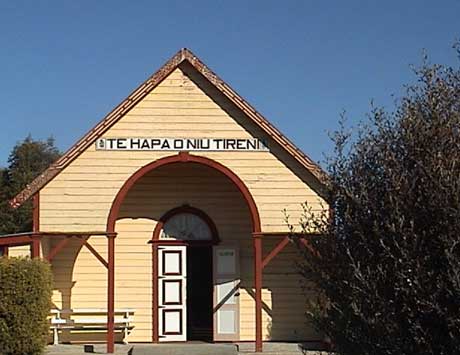
A reporter interview Mr Pita Moko Ratana’s private secretary asking about the healings that were performed while the faith healer was in Temuka, he replied “there were several cases of cripples and some blindness”. One gentlemen in particular who came with two crutches walked away on one crutch, he was expected that the other would be discarded that night. Another elderly gentlemen had to depend on a stick to walk with for years, he was attended to and was able to leave his walking stick, and immediately walked from one end of the meeting house to the other, a distance of 59 feet. On Tuesday and Wednesday, discussions and debates were taking place with the healings sessions Ratana focus then holding Church service in the evening. The Arowhenua Hall was first opened in the 1880s, by the Prophet Hipa Te Maiharoa but was burnt down on November 1903. The second hall was given a government grant of 200 pounds, and was reopened on the 30th April 1905, by the Prophets son Taare Reweti Te Maiharoa. The full price of the hall cost the people of Wai Taha 420 pounds. Ratana and his party departed from Temuka on the 28th July 1921.
(Nelson Evening Mail August 10th 1921; Editor WM, August 1967: pg9)
(Te Rongo Pai Hou A T.W.Ratana Mangai Sheet No.38-39)
On Thursday 28th, Ratana’s arrived at Port Chalmers, the Kaik (Otago Harbour). The utmost secrecy was maintained regarding his visit where Ratana would hold a private memorial services dedicated to the people of Taranaki who were kept as prisoners in caves along the coast. Mr J.H.W.Uru MP for Southern land would accompany Ratana and his party. Ratana’s visit to the Kaik was very brief; he left the following day from where he proceeded north by the second express for Little River. (Temuka Newspaper Thurs 28th July 1921; Otago Daily times July 30th 1921: pg9)
(Te Rongo Pai Hou A T.W.Ratana Mangai Sheet No.38-39; Editor WM, August 1967: pg9)
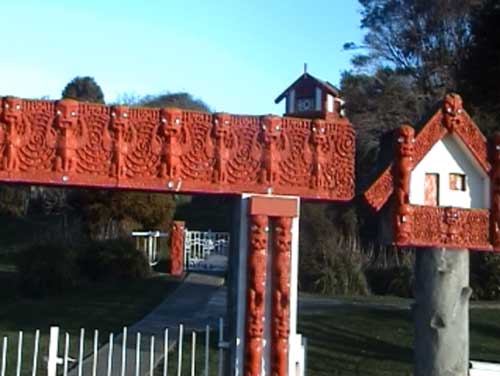
On the 29th July 1921, Ratana travelled to Orari and to the Onuku Marae where the Tiriti O Waitangi was signed in 1840. After his brief visit of the South Island Ratana and his group returned back to Ratana Pa.
(Te Rongo Pai Hou A T.W.Ratana Mangai Sheet No.38-39) (Editor WM, August 1967: pg9)
Mr Ratana and his party toured the South Island, between July and August visiting various towns and Marae removing Tapu. Ratana delivered spiritual and physical healing among Maori. Europeans were being healed and conveyed by correspondence. While in the South Island, T.W.Ratana attended to issues relating to the grievances of Maori concerning with the Tiriti O Waitangi.
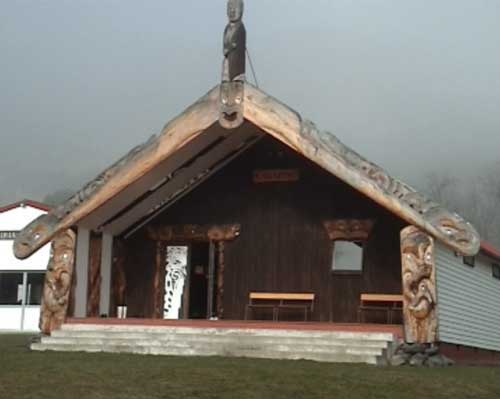
Ratana and his party travelled back to the South Island on 20th August 1921. He headed towards Marlborough arriving on Friday, where he left the train at Spring Creek and travelled to Wairau Pa. There were a large number of crippled and diseased Maori waiting for his arrival that were conveyed to him to be healed. On Sunday religious services were held, Ratana occupied a tent and in the presence of numerous Maori cures were carried out, there were also numerous cases by correspondence. (The Nelson Evening Mail August 22nd 1921)
The second part of Ratana’s South Island tour began in Marborough where they left the train at Spring Creek and travelled to Wairau Pa where a large number of crippled and diseased Maori were conveyed to him to be cured. Many miracle cures were performed upon the sick and the lame. On Sunday Whakamoemiti (church service) was held, then followed by Ratana who occupied a tent in the presence of numerous Maori who wanted to be healed. Two cripples who had to be carried to T.W.Ratana Mangai were able to walk without any assistance. After his brief stay Ratana and his party left Marborough by motorcar for the Nelson district proceeded to Picton, where they continued their journey to Nelson arriving early Tuesday morning 23rd August 1921, and continue the journey to Motueka the same day. (The Nelson Evening Mail, Monday August 22nd 1921)
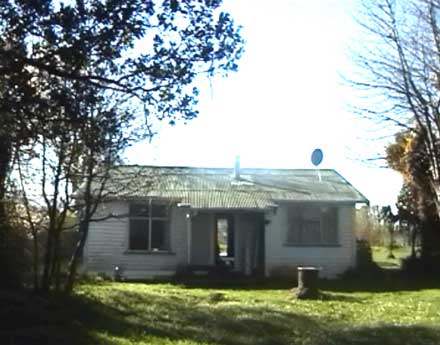
A young man by the name of Carl Heslin Junior, the 23 year old son of Mr Heslin of Tainui Street Greymouth, from the age of five has been very blind caused attributed to measles. Carl and his parents had been writing to Ratana for the past four months and heard that Ratana would be touring the South Island. They asked Ratana to pray for their son’s recovery asking for his intercession for the regaining of his eye sight. The news was delivered to the Heslins on Friday morning, a reply from T.W.Ratana and was delayed to him by his parents and not long after having it read to Carl he noticed an improvement in his eye sight. In his letter addressed to him by Ratana, the Faith Healer urged Carl to trust in God Almighty for his blindness to be remedied, and to pray continuously. By Saturday, Carl Heslin could distinguish daylight and detect not only shadows, but also the movement of people in front of him. Carl was also able to see his father working in the garden, and could distinguish the outline of the Post Office and other buildings near his home. By Sunday, Carl Heslin was able to perceive certain outlines of people’s faces, furnisher including sunlight streaming through the windows. Young Carl was able to write a letter to Ratana thanking him for his intersession and prayers. He was able to walk freely around the room with out walking into furnisher as one representative from the Grey River Argus witnessed Carl walking straight towards him for his interview. Mr and Mrs Helslin were greatly moved about their sons progress that he could once again use his eyes with effect considering being blind for eighteen years of his entire life. (Grey River Argus Monday 22nd, Tuesday 23r d, August 1921)
(Grey River Argus, Wednesday 24th, August 1921)
T.W.Ratana was sent an extended invitation by the Maori from Takaka, to visit their district while touring the northern portion of the South Island. Ratana had decided to visit Motueka as the most central location to visit his people. While in Motueka they would stay at the resident of Mr H.P.Paaka (Park) of Whakatewa Street, Motueka. The Maori of Takaka and Motueka were assisting the preparations to erect tents, construction of ovens, and other arrangements. The housing and provisions were seen by the local tribes on Mr Paaka’s grounds. A representative of the local tribe met Ratana and his party in Nelson and accompanied them back to Motueka. Ratana was expected to leave Motueka by the Kaitoa boat for Nelson and departing to Wellington. Ratana’s visit caused a tremendous amount of interest among the Maori and Pakeha, with senior leaders from local tribes will meet Ratana and his party in Nelson and accompany him to Motueka. (Te Rongo Pai Hou A T.W.Ratana Mangai Sheet No.38-39)
(The Nelson Evening Mail, Saturday August 20th 1921)
Fanny Lammas is one of the famous cures recorded in the Ratana History. The first nineteen years of her life she had been crippled and suffered severe pain doing simple things such as grasping a pen. She wrote just a few words to Ratana seeking help as she had heard so much about the wonderful cures being performed where the patients regained full strength of their limps. As Fanny Lammas lay in bed she looked at her watch to record the time, it was exactly 5.30am February 24th 1921. This miracle began to take effect 19 hours after she received her letter from Ratana. As Miss Lammas recalls she couldn’t remain in bed any longer, her body began to vibrate with a supernatural cleansing she no longer felt shaky or giddy she felt perfectly strong. She took her first step, the wondrous power of the Holy Spirit began to manifest through her, a severe stigmatism of the eyes which she had worn glasses was removed and also severe rhematic pain.
As Miss Lammas said
“I had spent a whole day in prayer. I felt a most wonderful sensation of strength and healing rush through my body, and I knew in an instant that I was cured. I had lain in bed utterly helpless for a year, for five years unable to work, for nearly 20 years able only to move a little by means of steel, which enwrapped my whole body. I rose to my feet, walked round the room, and called out to my people to come and see the miracle.”
People throughout Nelson from different Churches were praying, and gave thanksgiving service to celebrate Miss Lammas recovery. This cure became of great interest and people began to take notice of the healing and miracles that were being performed. As time passed on Miss Lammas continued to improve in health, and began to gain weight. The last of 30 medical advisors who treated her case knew that this case was a remarkable one It had been nine years since Miss Lammas was able to take a trip from her home. Miss Lammas left Nelson and visited Wellington, Wanganui (that included Ratana Pa), and Te Aroha. She visited Auckland staying at a hotel, which she had to climb three flights of stairs to reach her room. At the request of Mr Ratana, Miss Lammas spent a day at Ratana Pa. Her time with T.W.Ratana discussed how people were still sceptical about his work and that they still demanded absolute proof of his cures. (Kemp Rev Joseph W) (WM Editor, 1966: pg13)
Miss Lammas replied, “I am only to willing to talk to any clergymen, or doctor or anyone else who seeks proof. If it had not been for you I should either be dead or enduring what was little more than a living death, the only form of existence I had known for 19 years.”
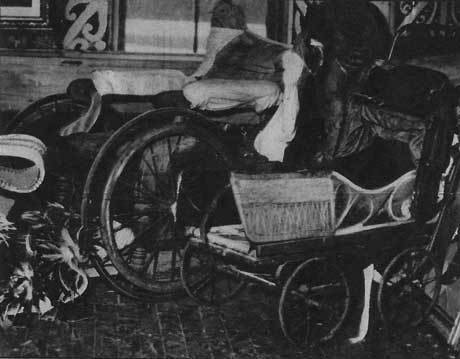
The cure is described in a booklet by Miss Lammas and edited by Rev. Joseph W. Kemp, minister of Auckland Baptist Tabernacle New Zealand a principle of New Zealand Bible Training Institute. This booklet was published by the Book Room Tabernacle Auckland NZ and is titled “How I was Healed A New Zealand Miracle” an autobiographical sketch of Miss Fannie Lammas Nelson New Zealand.
“It was in February 1921, that she heard about the Maori they call the Miracle Man, and that he was curing people of all disease, and hundreds of Maori were flocking to him. At first she didn’t take any notice of Ratana, when a family friend who was a minister from Wanganui called in to see her, and that he had heard many stories of Ratana’s patients who had been cured. God was using Ratana and that he was healing the people. People who suffered with cancer, insanity, blindness, deafness and many other illnesses were cured. Many of his patients were also healed through correspondence. And as we know she finally contacted Mr Ratana who said to through correspondence if you have enough faith and you believe then you shall be healed”. (Editor WM Paikea P, 1928: pg8)
Mr Peter Moko Ratana’s private secretary recalls there were over 287,000 letters were written to Ratana and hundreds of crutches, spectacles, rubber-bottom canes and medicine bottles were left at his place from the grateful men and woman who acknowledged that they had be cured. One letter sent from gentlemen who lived in San Francisco was dated 25th September:-

San Francisco, Cal: September 25th
Mr Ratana: - “About three weeks ago, I wrote to you for help for my eyes. I can now read a newspaper without glasses for the first time in about 25 years. I thank God and you with all my heart” Yours in Truth and Love.”
I received your letter today; I thank you so much for prayers. I thank and praise God for healing me, as I have been ill more than a year through an accident. I will sing his praise. I praise the Lord I can walk now. I will sing his praise. He is a wonderful God. He has healed me, poor me that am unworthy, but Glory is to the Father, Son, and the Holy Ghost. God bless and prosper you in the wonderful work you are doing. I will pray for you. Yours faithfully. (WM, 1967: pp16-17)
The most renowned Missionary to live at Ratana Pa was Reverend A.J.Seamer, a Methodist General Superintendent. Father Seamer moved to New Zealand from Australia, he was part of the Salvation Army and began his work in 1897. In 1920, at the Methodist Church conference T.G Hammond retired from his position allowing Father A.J.Seamer to step into the leadership for the Maori work. He was a close and personal friend of T.W.Ratana that began a long and significant association between these two men during 1920, through the 1930, until Tahupotiki Wiremu Ratana’s passing away in 1939. However, at this period during the early 1920, the thoughts in the minds of Maori believed, this would be a perfect time for a Maori Church to arise, they believed European Churches brought division into their tribal life. The Ratana Movement did eventually arise and would move all aspects of Tohungaism from its teachings, acceptance for the Biblical Christian principles be used turning away from the old Maori beliefs. Great Maori leaders such as Paraire Paikea and Hapeta Renata from the Methodist Church felt compelled to follower the Maori Miracle Faith Healer Tahupotiki Wiremu Ratana. These men would become key figures in the rise of the Ratana Movement and the Ratana Established Church New Zealand. Father Seamer witnessed T.W.Ratana Mangai Divine Healing, which created quite a stir among many Maori and Pakeha during the early years of the Movement. He supported the Ratana Movement during its unsettled period, which he endorsed the policy adopted by the Ratana Established Church New Zealand. Ratana’s relationships were that with the Rev A.J Seamer, in Maori eyes, was one of the last European missionaries to acquire heroic status in the twentieth century.
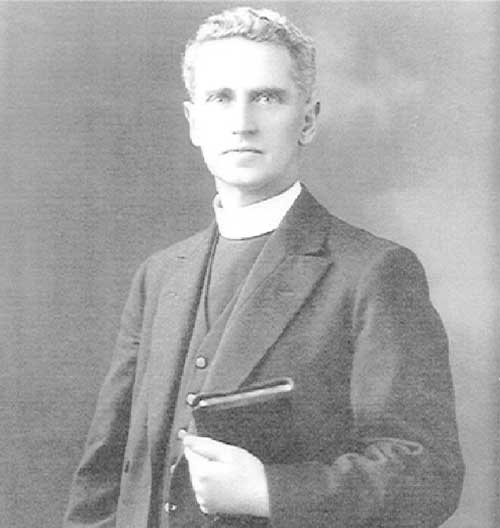
Father Seamer consulted constantly with Ratana leaders, was one of the key members that wrote the original draft of the "Ratana Church Creed" (Kaupapa o te Whakapono) which was prepared and deposited, therefore, the Ratana Established New Zealand came into being. Although Seamer suffered ear damage to his inner ear during the First World War on the Western front; he also suffered from arthritis that frequently restricted his movements; but he rarely complained. Seamer was still active in doing his work until he retired in 1939. He was a loyal and faithful servants to God and amongst the Maori people at Ratana, then later in his work for the Maori people in the Tainui area. In 1936, the Maori Mission Deaconess Group were also helping out with Father Seamer at Ratana. Many of the people at Ratana remember the Deaconess sisters Hobb and Rangimarie, who started Sunday school in the old Piki Te Ora Church that Ratana had given to them for the purpose to teach the children about the Maramatanga its Christian principles. Ratana asked Father Seamer to take over the care of the children of the Movement; therefore, he placed the needs to host the children in the hands of the Methodist Church, which the Church building Piki Te Ora would be utilised for the teaching of the Maramatanga. (Methodist House)
Eventually Methodist Church was allocated a site to erect the Methodist Mission Cottage for the Methodist workers. In 1927, the Methodist Church had one of the largest Maori schools in the country It was also the Methodist Home Mission that set up a programme to expand the Ratana School; they sent Mr Oliver Haddon and his wife to become the new Schoolteachers. Father Seamer was honored by having a street in the Ratana Township named after him. There was a long association between Wiremu Ratana and Father Seamer right up to the time of Ratana’s death in 1939. (Kara Book, Pene K: 1990)
A well known Wellington business man who was spending time in Wanganui during the Christmas period heard about Ratana as the miracle man and so out of curiosity travelled out to Ratana Pa to see for himself the powers of this faith healer. His experience was overwhelming which he described to one of the representatives from the “Wanganui Chronicle”. He witnesses five people that were totally blind and within a short time they were cured and enjoyed the blessing of sight. He learnt that during that holiday season T.W.Ratana (Mangai) treated 347 cases of which 17 were totally blind and were totally cured. (Editor WM, 1966: pg4)
There was a young European girl who was hopelessly crippled who was driven to Ratana in a taxi. At that time T.W.Ratana was conducting service in church. The people involved with Ratana’s ministry informed him that the girl was in pain, which he stated he would attend to her once service was completed.
“Go back to her and you will see that the pain has disappeared.”
They returned to the girl and found she was in no pain. After service Ratana went out to the child and told her come walk with him to church. Her friends were smiling with tears and told the healer that the poor girl could not move a hand or foot much less walk. Ratana only smiled and turning to the girl he said again, “Come walk with me to church.” And to their amazement of her friends the sufferer stepped out of the taxi walked to the church and later returned healed and in full enjoyment of her limbs. (Editor WM, 1966: pp4-5)
People would gather together and share their testimony to the wonders of miracles being performed. Ratana would devote his time to the benefit of his poorer brother and sisters of his own race, but the people heard of the urgent European cases that had been treated during the past 5 days. One was the little girl and the other a gentleman from Gisborne who arrived on crutches and within 2 hours went away without them. He left 50 pounds on the table near the healer. Just before the man got out of the building Ratana saw the cash on table and said;
“Friends, someone has left some money, who is it?” Turning back the gentlemen replied!
“I have left you a small recompense for the great good you have done for me.”
Ratana replied! “You must take it away, for I cannot accept payment. My work is a labour of love, and I am but doing my religious duty.” (Editor WM, 1966: pp4-5)
The most interesting aspect about Ratana ministry in the early 1920s, is that in those times faith cured. One may deny this but for the hundreds of cases that have been investigated by many sceptics they have been found true. In the Old and New Testament cures are mentioned and have happened throughout the ages. Questions were always being asked about Ratana’s mission, what was the secret of Ratana’s work, what was his object, what are his methods, and does Ratana hold that gives him special powers?
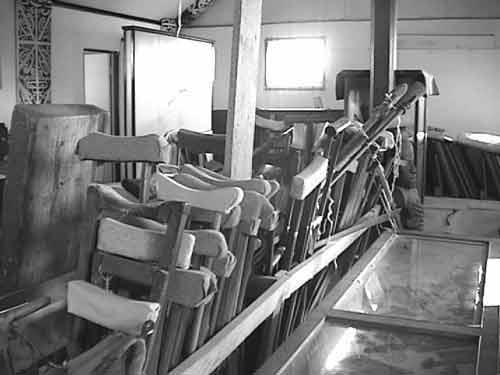
Mr Moko, Ratana’s Secretary would reply “Faith in the One God, Father, Son, Holy Ghost. Mr Ratana has faith and he demands faith from the patient, but it must be full faith.”
According to Pita Moko that objective was to win Maori from Tohungaism, five thousand men and woman have been cured of various diseases have now signed their names in the book entering into covenant, relations with God. They had to simply and solely have implicit faith in the One True God. Some of the other cases that were being treated were influenza-epidemic, whooping cough, bronchitis, cancer, blood poisoning as well as blindness, rheumatic and nervous troubles. People from different nations that have different protocols, cultures, belief systems and life styles, yet we are of the same species. However all mankind still are the children of the Heavenly Father, the creator of all things that do exist the author of all life. There is only one heavenly Father, and there is only one faith that is beyond all understanding of man. The Holy Spirit, that proceeds from the Father revealed many things to mankind, proclaimed by his Faithful Angels and his Prophets. His Son Jesus Christ was made manifest to redeem man to reveal to man’s consciousness his sins and their correction and lead man to trust and rest firmly upon the Saviour transforming his heart and mind until he becomes Christ like in holy love. By faith Abel offered unto God a more excellent sacrifice than Cain by which he obtained witness that he was righteous God testifying of his gifts and by it he being dead yet speaketh. By faith Enoch was translated that he should not see death; and was not found because God had translated him for before his translation he had testimony that he pleased God. (Editor WM, 1967: pp5-7)
Ratana’s reputation as a faith healer was preceding him, and the English and American papers copied the newspaper articles dealing with him and his ministry, thus his story unfolded throughout the world. At this time, Ratana undertook the journey to travel around New Zealand, preaching the unity of the Maori people under the one true God and healing the sick and infirm. Many followers from other Maori Movements and other Churches became followers of Tahupotiki Wiremu Ratana and his divine ministry. The main Marae and districts Ratana visited between 1922-1923, in the North Island were Waikato, Waitangi, Oihi, Taurua Pa and the other Tai Tokerau areas.
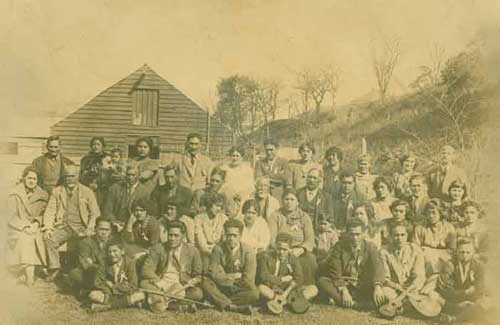
In the beginning mainstream churches supported Ratana and his work, if not all of the church leaders, seeing the positive results it was having on the Maori people throughout Aotearoa supported Ratana. They at first lauded his work of turning the Maori people away from Tohungaism to faith in the one true God, and his healing of the sick and infirm through faith and prayer. However, as time went on some of the mainstream churches began to turn against him. These clergymen did not favour the teachings or the inclusion of the Faithful Angels (Anahera Pono) and in later years the inclusion of the Mouthpiece (Mangai) into the prayers of the Remnants (Morehu) into the divine hierarchy, and his referral to God as Jehovah.
It was claimed that this amounted to “Polytheism” with the (Worship of more than one God) and therefore, was wrong from a Christian viewpoint. (WM Te Tai, 1925; Otago Witness August 4th 1925: pg26)
Mainstream Churches were afraid of losing their sheep, as growing numbers were starting to migrate to Ratana Pa to see and hear for them selves the wonder of miracles cures and the preaching of the Maramatanga delivered through T.W.Ratana (Mangai). The result became apparent, with nearly all of Maoridom chose to follow the faith healer and his ministry. Although they became his follower Mr Ratana always encouraged them to remain loyal to their own respective Churches. Problems began to surface as he noticed, as his followers went back to their own churches to marry or to have their children baptised, but were denied the right on the grounds that they were followers of this so called Mr Ratana. Mr Ratana was deeply hurt, that these people inspired with the enlightenment were denied those sacraments. (Elsmore, 1989: pg191)

They were now approaching Ratana’s chosen disciples to ask if they could marry then and have their children baptised. In some cases they resorted to living in de-facto relationships, which in those days was frowned upon as a sin. These disciples were not allowed to marry these couples; they were not registered under the New Zealand Marriage Act. There was only one way to help the Morehu that was to register an organization or form a Church. During 1922-1924, Ratana became concerned with the common everyday problems of the people. The Treaty of Waitangi and other social and economic problems began to surface and were the focus of discussion. He always encouraged the people to take positive interest in these matters, and promised that he would one day address these matters personally. Personnel records and notes kept by various secretaries over the years were the only records of the work between 1919, through to 1923, of sermons and teachings of Ratana. The Ratana community now was able to make provision for various facilities and services necessary for their collective welfare, sanitation, education, roading, water reticulation, sewage many other needs that were required for the people living in the new developing community. The population of the Ratana settlement had not peeked, children were coming and going continuously with most of his followers more interested in religion and in Mr Ratana’s wonderful faith healing work. The state of affairs prevailed until 1923-24, with the population in Ratana began to assume some measure of stability with the hunger for spiritual and religious hunger of the people had by now been replenished, they were now in the mood to attend to their physical or material welfare. The people now were ready with the task of seeing to the education of their children. (WM No.1883-45 February-March; pg4)
In 1923, the emblem was changed from the Rosette to the three-leaf clover. This depicted a badge in the form of a three-leaf clover with the top ‘Leaf’ coloured blue representing God. The ‘Leaf’ to the right was white representing the Son of God and the leaf to the left red representing the Holy Spirit. The ‘stem’ is purple representing the Faithful Angels (Luke 1:19). Ratana Mangai introduced for the first time, the teachings of the Angels and the works of the Angels Gabriel and Michael the two Arch Angels who came to help Ratana at the very beginning of his divine ministry.
The first five-pointed star was seen on the dress uniform of members of the first world tour group 1924. Shorty Dan is seen wearing a five pointed star ribbon and Henare Toka is seen here wearing a different type of ribbon. Both Tohu had no colours, the history behind the early origin of the star we look at the changes and developments of this symbol.
Tahupotiki Wiremu Ratana had announced he would take the most strenuous and ambitious of all tours consisting of a group of 24 young musicians. He establishment the first Band in the Ratana Movement “Te Peene A Te Mangai” 24 piece band a group of specially selected young people; 12 young woman and 12 young men that would perform haka, and poi dancers that will take British Empire Exhibition by storm. He was accompanied by a group of Kaumatua and Kuia to the British Empire Exhibition. The first world tour would commence from the 9th April to 12th December 1924, and the second leg of the world tour 17th August to the 21st December 1925. T.W.Ratana will also take the grievances of the Treaty of Waitangi to Geneva with no support from the New Zealand Government.
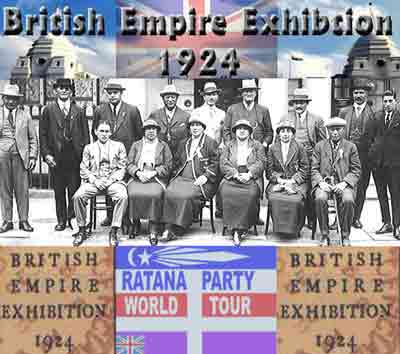
O Aotearoa, Te Waipounamu Me Whare Kauri. This Council would represent the United Morehu Nation responsible for seeking ways and means to ensure the ‘Social and Economical Advancement of the Maori people of Aotearoa, Te Waipounamu and Whare Kauri’. T.W.Ratana became the President of Te Runanga ote Kotahitanga. This Board was formed on the 25th May 1923, which became the governing body of the Ratana Movement. The Ture Tangata structure in the Pa also consisted of sports, cultural, educational and musical groups. The Maori cultural group and orchestra formed in the Pa accompanied Tahupotiki Wiremu Ratana and his Roopu on the 1924 World Tour.
First Chairman of Te Runanga Mr. Hema Te Ao
First Secretary of Te Runanga Mr. Kehu Maraku
First Premier (Pirimia) of Te Runanga Mr. Hare Tauna
Komiti Takiwa and Komiti Whaiti setup
By the time these committees were setup and functioning, Komiti Whaiti and Komiti Takiwa (Church Committees) were operating out in the Provinces. The foundation of the works of the Ture Tangata was thus setup. In its effects to improve the Social and Economical lot of the Maori people the Kotahitanga in its wisdom decided to form an investment society. This notice was published in the 1924 Whetu Marama
Ratana spoke several times about the concerns of the Kotahitanga relating to Komiti Whaiti and Komiti Takiwa that were been registered under the Kotahitanga. Ratana decided Paraire Paikea would be the officer in charge of those committees, insisting he should return to Ratana Pa to undertake his new role. All books and documents would be return to Komiti Takiwa they would be responsible for processing applications for loans from Kotahitanga. All agents that were authorized by the Kotahitanga to collect money on its behalf were asked to return all coupon books together with all finances relating to them by the end of the month. The Kotahitanga began to issue new books to ensure that true accounts of finances would be handed to the people by Christmas.
“The Bank of the Kotahitanga of the Morehu whose purpose shall be to work for the advancement and good of the Maori People of Aotearoa, Te Waipounamu and Whare kauri.”
When Ratana spoke to his people he told them when they came here to be cured of their sickness or ailments, they never made it clear whether or not their bodies and souls had been ‘leased’ under the control or treatment of the Tohunga or doctors; only when their cases became difficult did they reveal this. These people began to apply to the Kotahitanga for loans to improve their properties and to buy land for farming, some concealed the fact that the land declared as security for their loans had been committed to these Tohunga, and that they had already signed away their land, in some cases the land was already up for sale. However, he would say, “Oh Morehu, it doesn’t matter how you act, in this Maramatanga, all will be revealed in the end”. (Akoranga Anaru, 1997: pg9)
From February to May 1925, there were hardly any reports on the work and activities of the Ture Tangata. This was mainly because Mr Ratana and his people had their attention focused upon the matters of forming a new Church of their own. Affairs of the Kotahitanga “Bank” were being wound up. Unfortunately, there are no records available which might cast some light on exactly how the “Bank” and its business were finally put to rest. However according to the statements made in later years by certain elders, it seems that this was resolved with as little fuss as possible, mainly so that innocent people would not be hurt or brought into disrepute. It has also been said that Mr Ratana, with the support of his family, settled all final account of the Bank.
By 1925, Ratana started moving forward into the Ture Tangata aspects of his mission (Physical Works) one aspect was to form a church for Morehu but felt is was not the right time. However, the Morehu who still retained their individual Tribal statues where upon their own areas were allocated to build their homes and meeting houses. During 1925, Ratana had many of the mainstream churches solidly behind him, they supported his work, the praise of his work and teachings were recognised by clergy from prominent churches. However, behind the scenes petty arguments and jealousies of ulterior motives from others had become apparent among the people, both Maori and Pakeha. Tahupotiki Wiremu Ratana’s message to his people was again most important, his message at that early stage of our civilisation had begun to sound commonplace and empty, because it was something that was being preached by many and practised by few. Various church leaders who had once followed him travelled with him and acclaimed his work, deliberated with him, began to show their true colours; they began to reveal the real reasons for their apparent interest and support, they wanted Ratana to join their church, each of these leaders had their own faction, and supporters among them. At this stage Ratana, realised that to accede to wishes of anyone of the churches would result in dissention, disruption and chaos among his people. Ratana knew that the result of almost seven years hard work and personal sacrifice would topple and be ruined should he be influenced by other church leader personal quest. He made his decision and decided that he would form a church, that God inspired him, this was the beginning, not only of the Ratana Established Church New Zealand as it is known today, but a Movement and Church with many beautiful teachings and marvellous developments that combine to make our Maramatanga of all Christian organisations. (WM No.1865-66, August-September 1981: pp3-4; WM Te Tai I, May 31st 1925; Akoranga Anaru, 1997: pg23)
The Creed of the Ratana Movement and Church was signed by the original Apostles giving their appointment of Tahupotiki Wiremu Ratana as the Tumuaki was conveyed to the Registra General’s Office. One individual who supported Ratana and his work was Father Arthur John Seamer, who is remembered as a person who carried love and devotion and compassion for his fellowmen, was regarded as a counselor and a friend to Tahupotiki Wiremu Ratana, who was one time President of the Methodist Church. Father Seamer was a close friend and advisor right to the end, living with Ratana and his family whenever he visited Ratana Pa.
On his return from the 1924, world tour, Ratana found that a Church had been registered, supposedly “his church” because of certain social pressures of the time. He immediately set out about undoing the wrong, Mr Ratana deregistered the Church that the had been formed and completely dis-associated himself from the whole affair. It was not until 1925, that he agreed to confirm their decision. He then blessed and signed the registration of the Ratana Established Church of New Zealand. (Editor WM No.1865-66, August-September 1981: pg4)
(Editor WM Te Tai , 1925: pg2:) (General Registrar Office Wellington: July 5th 1925)
On July the 15th, 1925, the Ratana Established Church of New Zealand was registered with the Registrar General of Marriages, Births and Deaths in Wellington; Tahupotiki Wiremu Ratana was appointed as Tumuaki (President), the head of the Ratana Church.
The structure of the Ratana Movement and the Ratana Church combines within Jehovah’s Maramatanga (Divine Enlightenment). The Creed (Kaupapa o te Whakapono) that belongs to the Mangai and T.W.Ratana who signed the Registration of the Church.
After the Church was registered with the Registrar General in Wellington on July 15th 1925, the move was made to register the Ture Tangata section during November 1925. This was to be known as the Kotahitanga. The Ture Tangata structure had two functions.
- This dealt with work activities, polices and teachings concerning the Ratana Church and its people
- This dealt with the Tiriti O Waitangi, the Mana Motuhake land claims and policies.
(Te Tai WM, 1925: pg2; Akoranga Anaru: 1997; Registrar General Wellington: 1925)
On the 5th July 1925, at 11.00.am a light mist of rain began to fall in Ratana Pa, T.W.Ratana Mangai began to speak to the people indicating they were witnessing a spiritual occasion. This is known as the day the Mangai sealed the Church in the name of Jehovah, Father, Son, Holy Spirit, Faithful Angels, and their Mouthpiece
“He pata ua no te Rangi ka Hiiritia ki te Whenua, He auahi no te Whenua ka hiiritia ki te Rangi.”
“Ka hiiritia nei e ahau to koutou Haahi I tenei ra ki runga ki te Toka Kamaka, Matua, Tama, Wairua Tapu me nga Anahera Pono me te Mangai e kore ai e taea te whakakorikori, te whakangaueue.”
“A minute particle of rain from Heaven falls and is received by the earth becomes part of the earth; a wisp of vapour from the earth rises and is received by the heavens and becomes part of the heavens.”
“Like wise with your Church which, on this day, I commit, and seal, as part of the solid rock foundation of the Father, Son, Holy Spirit, the Holy and Faithful Angels and the Mouthpiece, upon which it shall rest unshakeably and undeniably.”
On the 23rd May 1926 at 2.30pm, T.W.Ratana Mangai dug the first Sod on the day of Pentecost where today the Temple stands. Although the weather was stormy and wet underfoot, this did not deter the Morehu from their purpose. After the opening hymn and prayers with a sermon conducted by the Mangai. Work began on the Temple on 23rd May 1926, it was built by voluntary labour with materials being purchased with funds provided by the people.
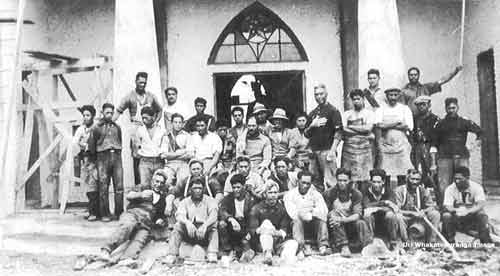
By 1926, Ratana, work increased with great intensity as he continued his preaching and healing work, he travelled around visiting his people making them converts, visiting many Pa’s and towns in Wanganui-Rangitikei, Hawkes Bay, Taranaki and Taitokerau districts. Ratana began achieving great results delivering Gods divine message to Maori and many over cultures throughout the world. There were approximately 110 Apotoro (Apostles), 500 Akonga and 500 Awhina doing Church work. T.W.Ratana was appointed President of the Kotahitanga, and by May that year, the Kotahitanga began to implement specific policies. There were 109 Districts and Committees (Komiti Takiwa) that were set up as well as 43 Sub-Committees (Komiti Whaiti) with an average of 10 members each. Those committees were responsible for running the business of the Movement and Church were required to make regular reports of their operations to headquarters. In the latter years other auxiliary committees had surfaced. With the organising of Ratana Pa and its affairs the task of seeing that his people throughout the country were adequately catered for. September 1926, Pepene Eketone gave an update on the documents of the Kotahitanga Land Reform plan (Huri Whenua) of which the Districts committees (Komiti Takiwa) and Sub-committees (Komiti Whaiti) National Police and National Health monitors would begin to assist in managing and co-ordinating these affairs. The first committee Marae was set up on the 27th May 1926, the committee being the headquarters of the Ture Tangata work in the Movement and Church. The first Post Office and the Ratana railway station were also erected in Ratana Pa.
(WM No.1867-68; October/November 1981, pp-2-3)
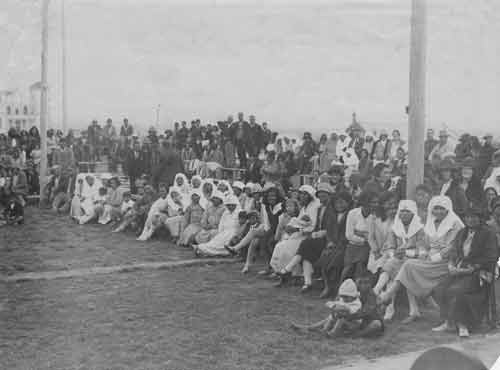
At the end of 1926, T.W.Ratana delivered a message to his Morehu concerning them and their faith. This is the following speech he delivered to his people concerning their faith.
(T.W.Ratana) “Ko te hunga e pekepeke nei ki waho o te tikanga, kia mahara koutou, ahakoa ahu kouou ki whea, o, uru atu ana ki tewhea Haahi, kia mahara ano, kua oti ke koutou te parani ki te parani o Ihoa, a, he wa tona ka hoki mai ano koutou ki te waahi I paranitia ai koutou.”
(T.W.Ratana) “No matter where they travelled, or what church they joined, it must be remembered, they have already been branded with the mark of Jehovah, and it will come to pass when they would return into the original fold in which they received that brand.”
(Editor WM; Te Tai: 1925)
Ratana warned the Morehu that those individuals that kept changing their beliefs would eventually end up where they originated. He continued preaching and healing, and still travelled around visiting his people, making more converts. He and his party visited various Pa and towns in Wanganui, Rangitikei, Hawkes Bay Taranaki and Tai Tokerau (northern) districts, and the South Island.
The Whakapono of the Church was setup, now their sites were focused on the start of a new Temple. As Ratana developed his theological standpoint, contention between his followers and conventional ministries increased as they stated that some of his teachings were contradictory to Christian beliefs.
The Gap between Maori and Pakeha showed that series of indigenous movement continued is in itself an indication that Maori still could not identify fully with the system of the Pakeha. The Methodists were more conciliatory and maintained a relationship with the new Church with the help of Father Seamer (Methodist Clergymen). T.W.Ratana Mangai warned his followers, to be on alert for the enemy meaning the devil, who had only one purpose and that was to destroy and divide, he encouraged his followers not to grumble and complain or bicker at each other, hey promised that one day the way would be clear for the Morehu to work having their own Apotoro, Akonga, Awhina having the authority to carry out the work and policies throughout the country knowing that the Holy Spirit would abide within their hearts help them in their works. Ratana told his followers their Church and Maramatanga would flourish if the spiritual work remains good and true, like wise with the physical works.
(WM Paikea P, April 30th 1927; Akoranga Anaru, 1997: pg27)
Between December 1926, to January 1927, Ratana’s work was completely dedicated to the construction of the Ratana Temple. The Temple became an a place of worship, in some respects the main lecture hall where Ratana would teach and preach, as with the utilizing of the Marae, Kii Koopu the Picture Hall and Piki Te Ora to deliver his message to the Morehu. In 1927, the "Kura Morehu" was proposed the Church and the Theological College came into full operation with a capacity of 23,000 members that covered the entire country. The Ratana theology is set up with parishes in many parts of the country. All apostleship are issued with certificates to indicate and endorse their duties within the Ratana Church hierarchy.
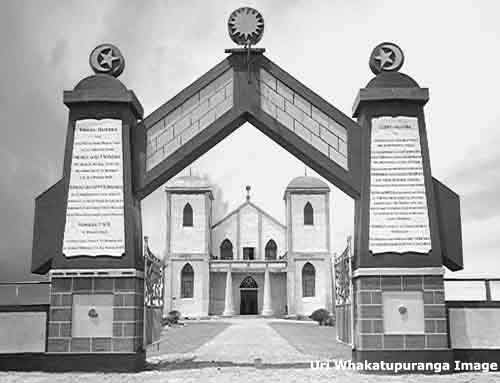
There were two official openings of the Temple in Ratana Pa. The first opening took place on the 25th January 1927; this opening was spiritual, and opened by T.W.Ratana (Mangai). The second opening took place on the 25th January 1928, was conducted by Bishop Juji Nakada from the Japan and Tahupotiki Wiremu Ratana (Mangai).
Cape Reinga is located on the top West tip of the far North. Many people flock in droves to observe the beauty and uniqueness of its coastline where the Tasman Sea and the Pacific Ocean meet. The history/significance it had on Maoridom is unknown to most people. The prophesy spoken by T.W.Ratana Mangai after his mission of mercy in 1928, “There will come a time when a house of great importance will grace the shore of this unique landmark”. (WM Wharangi T, 1957: pg3)
Today the Cape Reinga lighthouse is the predominating structure that stands there. That day the party began to survey the surroundings of Te Rerenga Wairua, when one of the local historians by the name of Raharuhi indicated to Mr Ratana that there was a cave just below him where he was standing. There was a stream flowing from within and flowing back out to sea. But that there was something very different about the colour of the water, it looked more like the colour red. Mr Ratana was assured that this red discolouration represented the blood type of the spirits that dwelt inside the cave. The stretch of water below the cave was called “Poka Torere” regarded as the bottomless abyss where the Tasman Sea and the Pacific Ocean meet and represents the dividing line, as the tide clash in opposing forces forming a course way of a foaming line which vanishes seaward towards Hawaiki.This Poka Torere, according to the historian resemble the path taken by the spirits which lead them back to Hawaiki from whence they journeyed from and never returned. On the other side of the cave is called Arawhata (Terraces). This represents the so-called stairway of the spirits into the depths and darkness of the unknown. On the opposite side there is a structure similar to a canoe shape, which is called the Aaka (Carriage). It represents the means of transportation that carried the spirits back to Hawaiki. This place is known as the bottle less abyss and will only be memory to a by-gone era.
(WM Wharangi T,1957: pg3)
As twilight began to fall, Te Ao Wirihana observed Mr Ratana strolling down along the beach, and noticed that he appeared to be walking in a trace like state unaware what was around him. So Te Ao left Ratana where he was and returned back to the marquee beside his wife where their child’s body was lying in rest. But when Te Ao looked up he saw Ratana standing there before him. Te Ao was amazed on how Ratana could be in two places at one time, with his sudden appearance out of thin air. The marquee became still and silence murmured through the campsite, T.W.Ratana began to speak, offering his condolences to the bereaved couple. Te Ao replied by thanking his leader for the words of comfort, then assured Ratana that they will accompany him in his quest to Te Rerenga Wairua. (Editor WM Wharangi T, 1957: pp3-4)
(T.W.Ratana) “I am deeply grateful that you have both come to an understanding at a very critical time of our stay here, and are in agreement to accompany me tomorrow. Secondly, the loss of your child is the culmination of a sacrifice in which God had intended, so that our mission will be successful by conquering the powers to be at Te Rerenga Wairua.” “Although we have lost a love one while on the other hand we have gained the knowledge of knowing that the obstacles which posed barriers of great power are now free and the way is now open to us in which we can proceed without fear of these threats of adversity. Why we may ask, because your child has made it all possible for us.”
“While I was strolling along the beach my mind was heavily laden with sorrow and the pressure became unbearable as I tried to put it aside. As I returned to the marquee I was relieved to find that the pressure that once applied began to ease and I new then that your faith and trust in me was fully restored.” But faith and trust are not the only things we believe in but it is how we apply them to those we are indebted to, and that is God. Therefore, you have both shown by agreeing to join me in our mission that we face tomorrow." (Editor WM Wharangi T, 1957: pg4)
The party of 127 strong began their final trek on foot as they headed towards Te Rerenga Wairua. Once they got to Waingurunguru, Ratana’s sister Raupo Te Poi became tired, however a horse was given so she could continue her way by horseback to their final destination. The party arrived at Hiireki where they rested for a short time. Then they continued on to Perunui by taking an alternative route and eventually they arrived at the area overlooking Te Rerenga Wairua. After the party rested T.W.Ratana assumed the role as Piri Wiri Tua and addresses the group by opening up with a prayer. The editor of the Whetu Marama dictated the following speech by spoken by T.W.Ratana at Te Rerenga Wairua (Cape Reinga)

“I cannot believe that we have arrived at Te Rerenga Wairua against mounting odds when carrying out this mission. From this day forth the Annihilation of evil around this site will no longer exit, giving great satisfaction and comfort to the demands of the local Morehu. I confess however, to prevent the cause of death among the Morehu is such beyond my powers to do so, and I do not for one moment believe that I am the equal of God. But I am assuring you that we can seek God’s forgiveness and help. Therefore, I pray that the souls of our people manifest itself through the guidance of their Faithful Angels and enter into the Kingdom of God, and may they rest in eternal life. “Today I address you all with great joy in my heart. The mission, which we set out to do have been accomplished by conquering the evil forces of this area forever. From now on the only significance this place shall command will be in name only and the memories that it holds for its future generation to relate to.”
(Editor WM Wharangi T, 1957: pg5)
Right through his Ministry T.W.Ratana always rejected the evils of the old ways of Tohungaism and the practice of Maori bowing down before the Maori Gods. In all his works he exhorted the people to denounce these practices. Maori people had to turn their hearts and minds back to the faith in believing in Jehovah of Hosts. Mr Ratana travelled out on many occasions to deal with destroying the evils of the Tohunga of old who had created fear among the people, which they imposed curses upon houses, marae, cemeteries and many other places. They also casted evil spells upon people causing them great pain and sickness, which sometimes resulted in death. Many people handed various kinds of artefacts that were infected by curses over to T.W Ratana Mangai so he might cast out those evil spells that were placed upon them by the tohunga. (Akoranga, Anaru; 231997: pg45)
T.W.Ratana Mangai began his National healing and evangelical campaign as early as 1920-1921, traveling throughout the North and South Island. Many Maori were affected by Mate Maori (Maori sickness), a disorder prevalent amongst Maori who were often required to carry objects worn around their necks or carried items as good luck charms as protection given by the Tohunga who prescribed certain restrictions and requirements. However, many families (Hapu) and tribes (Iwi) ceded over these objects of idol worshipping to Ratana through Covenants. Many family and tribal heirlooms, historical icons and signicant treatures her hand over to T.W.Ratana Mangai removing curses that hung over the people affected, with piles of crutches, walking sticks frames and wheel chairs discared and left behind by cured patients.

Many testify to twenty years of miracle and working delivered by the Maori Prophet Tahupotiki Wiremu Ratana Mangai. Many witnesses are crutches, sticks, back-straps steel frames and wheel chairs filling the Whare Maori Museum in Ratana Pa, dropped by infirm who claimed complete recovery at hands of beloved Leader of the Maori people. Highly practical evangelist Ratana brought prosperity to many adherents by founding model communal settlement. This building contains hundreds of crutches and other aids to infirm discarded by cure cripples. Tangipere Rangimakene was the Custodian of the Whare Maori between 1930-1950s.
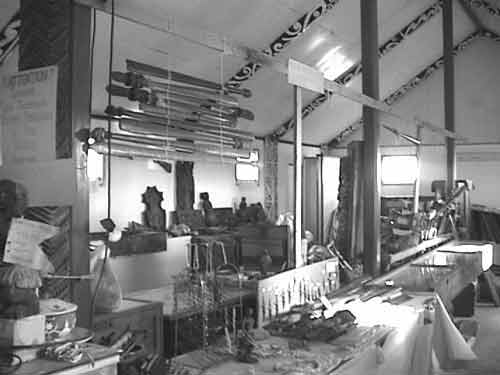
Most of these artefacts were placed in the Museum (Whare Maori) at Ratana Pa. Each one of these artefacts in the Whare Maori portray a story, a story of faith that as time goes on, speaks to the people now living in the present generation. Despite this, some of these artefacts have a far "darker side", and thus should not be removed from the Whare Maori. Others are suitable for exhibit in order to enhance the faith of those believers that understand the power of Jehovah’s Maramatanga and miracles performed through T.W.Ratana Mangai. Even during his healing sessions the hundreds of aids as crutches, spectacles, walking sticks and wheelchairs left behind testified to the miracles that had been performed. (Elsmore, 1985: pg191)
These artifacts were originally kept inside Mataatua house in 1920, which used to stand next to Piki Te Ora Church House. This house had no Maori carvings but had the traditional V shape with open verandah, door and window. However, several years later the Mataatua was converted to a sleeping quarter and accommodation to house visitors during annual Hui in Ratana Pa. In 1925, Mataatua House was then relocated to ‘Taranaki’ Park next to Ratana’s house Ora Kei Nui, opposite the administration block, next to the “Whetu Marama” Press and Office building. In 1929, “Mataatua” house was renamed “Te Whare Takotoranga o nga Taipo” years later the name was shortened to “Te Whare Taipo”. This was the same Mataatua building, but these carvings that were added were seven Waka, the resting place of Goblins. (Editor WM No.293, November 9 1929: pg7)
(Editor WM No.296, November 30, pp3-4: 1929; WM No.293, November 9, 1929: pg7)
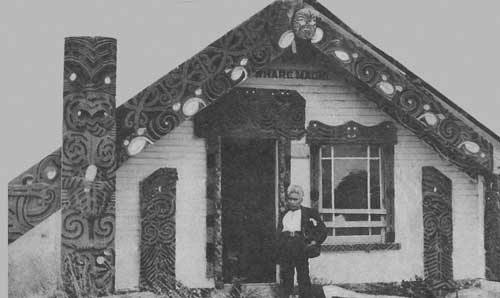
The original Whare Maori building was gifted in 1929, by Kingi Topia from Moawhango Ngati Tu Wharetoa decent. This building was a fully carved house of typical Tu Wharetoa traditional carving style. The original name of this carved house was Te Ika Nui A Maui meaning the (great fish of Maui) hence the figure of Maui and the fish hook on top of the house.
This building was renamed Te Whare Tekoteko and Te Whare Taipo and by 1933, was renamed Whare Herehere I Nga Taipo me nga Atua Maori, then was eventually relocated from Taranaki Park to a space directly far opposite Kii Koopu where its present location stands today, Te Whare Maori. Hamuera one of Ratana’s sons would pass away in 1934, signifying the passing of the old priest order and the conquering of black magic sorcery and bowing down to false gods. (Editor WM No.296, November 30th 1929: pp3-49; Editor WM No.293, November 9, 1929: pg7)
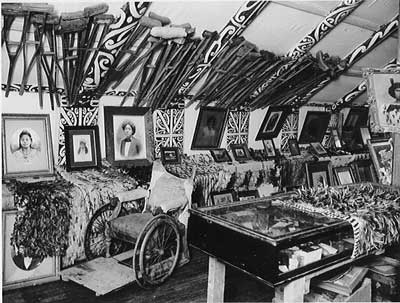
Apotoro Wairua (Spiritual Apostle) Kereama Pene mentions, it is taught that these evil spirits in some of the objects were only ‘put to ‘sleep’. “Morehu must not go back to the old evil customs (Te Ao Kohatu) from the stone age of our forefathers or the Atua Maori bowing down to false idols and praying to false Atua worship, this would awaken causing harm and destruction tenfold. The old saying is: “Ko Hamuera Te Whakaotinga or Samuel’s work is the Annihilation of Tohungaism.
For a long time these items remained on display in the mostly locked building which also housed old documents, diaries, books and genealogies important to the Ratana heritage. Unfortunately, the superstitions from the past seemed to linger with people fearing to enter the building after Ratana’s death, leaving it to fall into disrepair. Many believed that to care for the objects and items might reawaken the spiritual forces, which they believed still resided there. Many of the wooden artefacts had previously been treated against borers and varnished for protection. Other items including relevant books, diaries and other Ratana World Tour mementos had had been rescued for placement in the new Archive Museum. It is not known what happened to many of the other more controversial Tapu objects but today’s display is far less impressive than it once was during the 1930, and up to the late 1970.

Political Move (1928-1932 Period)
The two main reasons why Ratana went ahead to recapture the lost treasures for Maori.
1) He was approached by Tupu Te Waharia on the matter of the Tiriti o Waitangi and what he called “Te Mauiui Oneone”, when he came to Ratana Pa, during his early part of his ministry on the 24th December 1920, to talk with T.W.Ratana.
2) The efforts made by King Tawhiao, King Te Rata and T.W.Ratana to have the Treaty recognised by the British Government. (Akoranga Anaru, 1997: pg28)
By May 1927, with key components setup, Ratana was able to enter into the Ture Tangata (physical) aspect of his work, the political arena. This paved the way allowing him to investigate and implement his strategies for the ratification of the Tiriti o Waitangi, Mana Motuhake and rights and privileges to manifest for all Maori through Government Legislation.
On The 15th July 1927, T.W.Ratana prepared a trip to Waikato to visit King Rata and discuss issues concerning their “Taonga” (Tiriti o Waitangi), but unrest between the Waikato people and Ratana still abated his visit. After his trip of Tai Tokerau (Northland) the apparent reasons emerged between factions, this due to the bases of power, and who held the power in Maoridom. This did not deter Ratana away from travelling among the people and dealing with Church matters. Maori were crying out for ways and means of resolving their problems over their land. Ratana continued to speak out saying, if you the Maori people unite, your problems will be solved, and you will have no more problems with the Government and the issues of the Tiriti o Waitangi.
These are the main focal points that enabled Ratana to establish a foothold in Maoridom.
- The coming of the Maramatanga or fulfilment of the Prophecy
- The implementation of the Kotahitanga
- The Ratana Movement
- The Registration of the Ratana Church in 1925
- The Registration of Ture Tangata Section (Kotahitanga) 1925
- Establishment of all Ture Tangata committees. (Akoranga Anaru, 1997: pg50)
The physical mantle he took up would be know as Piri Wiri Tua; after his visit to Te Rere o Kapuni (Victoria Falls Taranaki). From 1928 through to 1932, Ratana T.W.Ratana Piriwiritua worked in the political realm of man. In this period of his ministry, he chose four men who would make up a team called Quarter (Nga Koata E Wha).
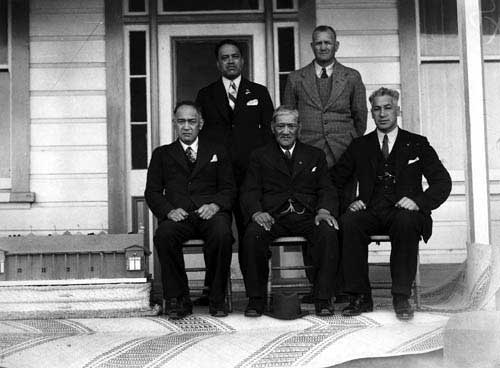
Go to T.W.Ratana for Political Page
T.W.Ratana turned his attention to organising the land to farm around Ratana. His plan was to sow wheat, oats barley, potatoes, kamokamo as well as corn for his people. His work force consisted of cooks who feed the workers, and visitors, tractor drivers, lorry drivers, labourers who were planting and sowing the crops. There were stable hands to take care of the horses, blacksmiths, boot makers and carpenters building new facilities. There were motor mechanics; you see the contingent of workers that were becoming part of the Ratana organization began to take hold as many Maori organizations throughout the New Zealand felt the full force of the Ratana Movement and Ratana Church.
Ratana’s concept of farming had a duality purpose, as he explained, that his job was to turn the black soil up on the top of the ground, and keep digging until he reached the red soil. He was referring to digging up New Zealand in a political strategy which to address his attention to the land, and the work of the Ture Tangata. As always he repeated his message to the people first if you unite under God, then we can turn our attention to the Tiriti o Waitangi. With the advent of Piri Wiri Tua, Ratana continued with his work in travelling and attending meetings relating to the Ture Tangata questions of land, policy and other physical problems affecting the Maori people. However, he never neglected the important part of his ministry that of preaching the Gospel, healing the sick and the infirm. Throughout 1928, he was still able to travel to Auckland, Waikato Wairarapa, and Hawkes Bay.
However, it wouldn’t be until October 1929, Piri Wiri Tua sent his Secretary to Wellington before the Royal Commission with reports on his wheat farming, which the secretary gave a brief account of the work being done on Ratana’s wheat farm. There were a 100 acres devoted for planting vegetables, and several acres were sown in barely and oats. Ratana was aiming at sowing 800 acres of wheat. Ratana had been given no assistance from the Government, when the chairmen heard this he directed the clerk to note this in his report. The chairman ended his proceedings by saying; Ratana’s wheat was of the highest grade in New Zealand making him NZ top Wheat Farmer.
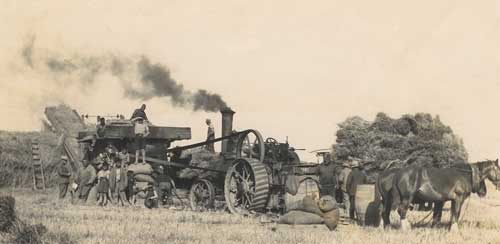
Many of the great Maori leaders had tried so hard to have the Tiriti ratified saw Ratana as their last hope for Maoridom. The political advance for the Ratana’s structure differed from Ngata and Pomare, and also from Carroll and Heke. Ratana platform would be an example in the bringing about of the ratification of the Tiriti of Waitangi. Ratana began to document his policies, which involved the problems of the land, before the signing of the Tiriti o Waitangi, and after the Tiriti was signed, to this present day. One of Ratana’s committees had the duty to investigate the many claims of the Maori people. By October, Ratana was ready to announce his four chosen candidates for the coming elections. The message was broadcasted to all Morehu throughout the land, through the Whetu Marama.
The relationship between the Ratana Movement and the Labour party originally stems back to 1925, with the young vibrant Harry Holland a member from the newly formed Labour Party. Wiremu Ratana’s Aunt Mere Rikiriki his uncle Inia Ranganui, Rangi Mawhete saw a means for Maori to have a voice which the new Labour party seemed sympathetic to the flight of Maori concerning the Treaty of Waitangi. There were many visits to Ratana Pa between 1928-32, by Parliamentary delegates wanting to hear Ratana's vision. Ratana’s goal has always been to provide a platform that would represent all of Maoridom and through various restructuring processes with Ratana Pa becoming a place where spiritual and political issues affecting all of Maoridom could be view as a transparent centre to work out their grievous to create a single voice for Maoridom. Ratana’s vision for putting right Maori social, political and treaty issues was always foremost, as he had explained to Tupu Taingakawa on Christmas Day 1920, kotahi, kotahi, kotahi, unite, unite unite. This was the requirement for the people to be united where by means, their dreams and prosperities would be fulfilled under the mantle of Ihoa O Nga Mano. (WM No.53 Te Tai I, March 28th 1925: pg20)
(1933 Period)
During 1933, T.W.Ratana revamped his two main committees Ture Tangata under Piri Wiri Tua who would be responsible for administering affairs within the Pa as well as dealing with Ture Tangata matters that may be sent from outside the Pa. The church committee under T.W.Ratana Mangai would be responsible for dealing with all Church matters throughout the land.
The aim of Mr Ratana is to have four Maori Members represent the Maori people in Parliament who would support and work for the Treaty of Waitangi. Mr Ratana’s message to his people on new years herald a sad and difficult time ahead for them. His message he delivered to his flock, in times ahead have courage, and be loyal, each one of you must bear his or her own cross. If you see your cross is falling re-adjust it. He continued by saying the manner in which you bear your cross will determine whether you will meet with good or bad.
T.W.R. Mangai, Piri Wiri Tua explained in his future prophecy, "the day is coming when the tail will become the head and the head become the tail". The people looked in fear as Ratana continued to express the hardships that would be approaching in the near future. He continued by saying if anyone should arise among you to preach to you, in the near future beware for that one will have the devil with him. You will see signs of the weeds and thistles that have been left behind by the weeder.
During 1933, Ratana attempted in building a University/School at Wai O Turi, near Patea was unsuccessful. He was trying to build a Tiriti University, which dealt with the content written in the Tiriti O Waitangi, and also to produce the highest quality of Maori workmanship from every arena (WM Tane M: 1933; Akoranga Anaru, 1997: pg112)
1934-1935 Period
Tangi of Te Rata
The death of Te Rata the Maori king ripple throughout Maoridom, Ratana was sent a message from Te Puea Herangi and Hanunui Tawhiao Ariki, asking if he would attend his Tangi. Once Ratana arrived on the Marae led by the Ratana Band, he stood up to give his condolences to the bereaved family, when all of a sudden he was interrupted by a man named Tutaneki who yelled out, who gave you permission to speak first? It is I who should speak first, not you.
Mr Ratana replied:
“I am greeting the dead, Te Rata, not you, the living. It is because of this man lying here that I have come to this place; I am paying my respect and saying farewell to him, not to you. Further, it was not you who asked me to come here.”
One of the Kings family called out to Ratana continue on with your korero (speech), nobody has the right here to stop you, and the man who interrupted you is not one of ours, we do not know him. He is from Te Arawa, so speak on. After Ratana finished his speech orators from the Marae rose to reply and to welcome Ratana and his people. During October Koroki was ordained as Maori King by the Clergyman of the Anglican and Methodist churches. After the ceremony, the Marae was open for general discussions. The discussion arose about the Treaty/Tiriti with Mr Ratana speaking on the significance of it; with the majority of those who followed spoke in favour of what Mr Ratana said. (Editor WM Tane M, 1933: pp3-4)
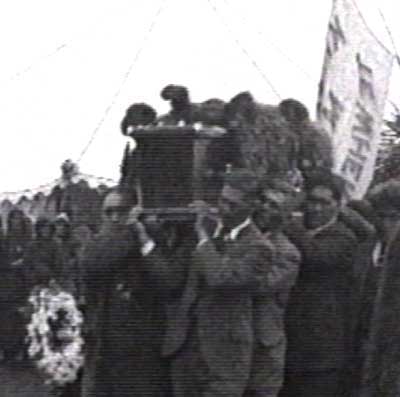
In 1934, king Koroki visited Ratana Pa, where T.W.Ratana gifted him three Taonga (gifts) a ring, a carved walking stick and a Maori feather cloak. He said to Koroki I give you these Toanga in the hope that they will serve as a reminder to you in days to come of our meeting and of your coming into the Temple today. An elder from Waikato by the name of Te Kiri Katipa spoke to the people he translated the interpretation of the Taonga to those gathered. The meaning of the Maori cloak represents Maori sovereignty, the carved walking stick represents spiritual power, and the ring represents a Marriage between the two people. These two people are the Ratana people and Waikato people.
(Akoranga Anaru, 1997: pg115)
Mr Ratana (Mangai) continued to speak the prophesies of this land, of Potatau, Tawhiao, Tohu, Whiti, and the others saying, “I have them all in the palm of my hand”; the Wa (time) already ordained that you should come here koroki that is why the wa and I persevered so long ago. Ratana said that I do not blame Waikato for taking so long to make up their minds for what happened in the past was meant to be, the right time for this to happen has finally come. (Editor WM Tane M, 1934: pg4)
While in Wellington T.W.Ratana visitied Parliament House with his senior members of the Ratana Church, Mete Keepa and Tirikatene and other Kaumatua and kiua. As they were entering into Parliament House, Ratana saw the Coat of Arms at the top of Parliament that had the emblem of the Tiger and Lion. He looked up at the emblem N.Z. Coat of Arms and began speaking to it.
"E te Raiona nei me te Taika, me te Karauna, he tohu nei koutou no te Emepaea o Ingarangi, ka tu nei ahau i runga i a Koe, a, ko koe hoki te mea Kaha; taku kupu, kia puta mai ano te mea reka i roto i a koe ki ahau, ara ki te Iwi Maori, otira ki te Iwi Morehu".
“O Lion O Tiger and the Crown, you are the symbols of the British Empire (England), but on this day I stand upon you, and as I stand before you, you are stronger than I. I say to you, let there be "sweet Fruits" for me (my people, the Maori) from you"
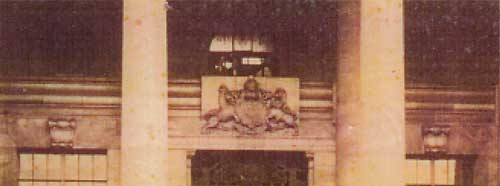
As he continued to speak to the chair in which the Speaker of the House sat he said to the chair of the speaker:
“To you the seat, I great you, for upon you sits the person who shall pass laws for me whether they be good laws for all the seats that are here, for upon you sits upon those who deliberate and decide my future for me”. “My word to you, say to those and to the policies and principles that are sitting upon your seats that you must do justly right justly”.
He continued by saying to all the members who were sit in the seats in the chamber to do their work well and fairly, and asked them not to permit the passages of laws that would impinge or hurt the Maori people, and if this is done, the root of the tree would wither and die (Me Pa-te-Titaha) and when the wind comes the tree will be blown away to be consumed by fire until only the ashes remain. T.W. Ratana Mangai planted the Geranium flower within old the parliament grounds to signify the Tiriti O Waitangi, which at a later date he would return to claim. (Symbolic for the Tiriti O Waitangi). T.W.Ratana spoke in parables to the congregation who were listening. Further he said to the members of Parliament:
“Greetings, greetings, greetings, to the chair in which Tirikatene sit. I pray that you and your occupant will have courage and strength, so that the work your occupant does will shine brightly over this land.” (Editor WM Tane M: 1934)
Later, T.W.Ratana Mangai Piri Wiri Tua arrived at the Upper House where they again sat on the chair of the speaker. He repeated the words he had spoken in the Chamber, he warned them to take heed of what he had said. In the Maori Affairs room he sat of the seat of the Chairman, again repeated what he said in the Lower and Upper chamber. The clerk placed before Ratana the documents, the claims of the Treaty of Waitangi and Te Mana Motuhake. These document were actually the same documents that T.W.Ratana Mangai and Piri Wiri Tua had sent that explained the Sacredness of those contents of the Treaty of Waitanga. After the speeches were conducted Mr Ratana rose and said: “O rain, fall upon this Parliament, let water spill upon it, so that, what I say, may be blessed and carried out” (Editor WM, Tane M: 1934)

Throughout the years Ratana’s Ministry still attracted more followers from every part of New Zealand. Many of these people brought with them their own beliefs and therefore much theological dispute arose among those gathered during the fellowship sessions. Despite such minor setbacks, the membership of the Ratana Church grew. Ratana’s long campaign to have his Nga koata elected to the four Maori seats in Parliament was still a reality to the Morehu and Ratana himself.
T.W.Ratana (Mangai) and his Roopu once again travelled back to the South Island, an invitation given by the people of the South Island tribes. They travelled by the Steam-Ship “Maori” from Wellington and landed in Lyttelton. Travelling by train arriving in Temuka the Ratana Brass Band played at the Railway station, delivering two tunes, Mura Ahi and E Pari Ra. Apotoro H. Te Reinga greeted Mr Ratana and his Roopu. The Mayor of Temuka gave an open invitation to Ratana for the Brass Band to march through Temuka Township. While in Temuka a rugby match between North Canterbury and South Canterbury was played for the T.W.R Challenge Cup Sports Trophy, with a hockey match being the curtain raiser before the main event. Ngaitahu donated a Trophy also a “greenstone patu” for the rugby match. Te Rauna Taiaroa led the South Canterbury team and Nuku Tirikatene led the North Canterbury team. Te One Tirikatene the youngest son of the Maori MP, Tihema Tirikatene (Nga Koata) had the privilege of performing the kick off. Mr Paraire Paikea MP (Nga Koata) another one of Mr Ratana’s member for parliament refereed the rugby match, with the final result locking the match at three all. (Editor WM Tane M, 1934: pp2-16)
On the 17th August 1934, the Ratana flags arrived in the South Island and were taken to Tuahiwi. Te Aika head of Ngaitahu Runanga, Waata Moumou gifted a Cup to Ratana (Turakautahi Cup). Healings were conducted by T.W.R Mangai that night, followed by the Ratana concert party performing in the picture hall at Tuahiwi.
On the 18th August 1934, Mr Ari Pitama and his party were waiting for T.W.Ratana Mangai to arrive in Christchurch. Ratana’s concert party were due to perform at the Christchurch Winter Exhibition to an audience of 6000 people. The next day Ratana continued his tour to Rangiora and Waiwera. On the 29th August 1934, Mr Ratana and his party arrived back in Ratana.
On the 6th September 1934, T.W.Ratana Mangai and his Roopu (party) returned to the South Island travelling by the Steam Ship Rangatira arriving in the West Coast of the South Island. They travelled to Poutini, Aorangi, Arahura and Hokitika where they visited the Haangi Marae. They were greeted by the South Island Kaumatua and Kuia (Elders) Awhina Mason, Rore Tauwhare, Iraia Tainui, Ema Tainui, Tipare Meihana, Kohere Weepe and Tuhuru Tainui in Arahura. Two green stone from the Arahura River were gifted to T.W.Ratana (Mangai). Both green stone were lodged in the Archway leading into the Temple at Ratana Pa. They continued to Lake Kaihinu, known for its small eels hence the name “To eat Fat”. They travelled to Lake Kanieri the Power Station and the Bottomless Lake. On the 10th September 1934, Ratana visited the Caves at Mawherae Greymouth for a memorial service, where elders of Arahura were buried. The last chief buried in the cave was Tuhuru, ancestor to Poutini. (Editor WM Tane M, 1934: pp2-11)
October 22nd 1934 (Hamuera Annilation of Tohungaism)
Every time T.W.Ratana (Mangai) was called by the people of the land to go out and attend to breaking serious “Tapu” to exorcise demons, his son Hamuera suffered. Hamuera would be wracked with pain, brought on by great sores and carbuncles, which broke out on his face, neck and other parts of his body. Some people were filled with sorrow for young Hamuera when put through these afflictions, however when his father returned from his mission he would recover leaving serious scars to his body. As Hamuera lay in his sickbed, his father sat beside him after speaking to the people of the Marae. Hamuera was distracted by noises outside, and turned to his father and he asked,
(Hamuera) "What is this sound i hear? His father replied,” it is the people debating among them selves on the Marae”. Ratana continued to talk to his son and he asked him, Hamuera, tell me, my son, when I go, who will lead the people?” Hamuera answered, “I will” then closed his eyes and died.Hamuera died on the 22nd October 1934, this was seen as the sacrifice of the annilation of Tohungaism. This day in October is known as the shining cuckoo (Pipiwharauroa). The sound of the singing of the shining cuckoo is heralded as the coming of the warm season of growth and reproduction in the world of nature. (Spring)
(Editor WM Tane M, 1934: pg1; Akoranga Anaru, 1997: pp29-30)
There are different forms of sacrifices mentioned in Biblical history. T.W.Ratana’s three sons Arepa, Omeka and Hamuera were pre-ordained by the Holy Spirit to play a very important role in the work endowed to their father T.W.Ratana. Arepa was the price paid for in the spiritual work (Ture Wairua); Omeka was the price paid for in the physical work, Ture Tangata and Hamuera was the price paid for in the annilation to wiping out evil influences of Tohungaism and evil practices amongst Maori. (Editor WM Paikea P: 1931-1932; Editor WM Tane M, 1932: pg5)
(Inscription on Memorial Archway Ratana Pa)
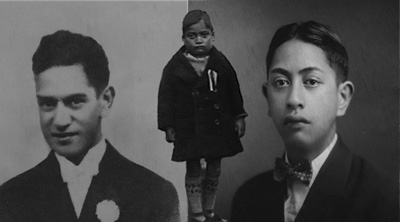
In Genesis, you see that the patriarch Abraham, who had great faith in God, was actually prepared to sacrifice his own son Isaac for the sake of Gods work. Many prophets of old had that same faith in God. That the work for the Glory of God and the benefits of man should always prevail no matter what the consequences or sacrifices were in their lives. God’s own Son Jesus was crucified to redeem man and to conquer the power of sin, of darkness and death. (Hebrews 10:12-16). Through this love, he sacrificed his own Son in the bid to free man from his sins and to lead man to trust, and rest firmly upon the Saviour, transforming his heart and mind until he becomes Christ like in Holy love. (Romans 8:1-16) (Kaupapa o te Whakapono: Clause Three 1925)
Music Era of the Ratana Brass Bands
Tahupotiki Wiremu Ratana legacy becomes evident to any visitor to the Ratana Pa. The Temple and its surrounding buildings bring an abundant source of history to all New Zealander who have not heard the story of Ratana. There is the importance on how music plays a big part in its history?

Mr Ratana used music as a form of spiritual enticing of the human heart and also as a form to ward off evil spirits. Like the Israelites of old, they believed musicians would lead the procession into the promise land and bring down the strongholds of the enemy. This was illustrated in the felling of Jericho's walls. We look at the impact of the music phenomena within Maoridom, the Ratana Movement and Ratana Church we begin to define the differents between the styles of music of that period to understand how Maori history, Morehu history and Ratana history pertaining to music played an important part in the cultivating of its spiritual and physical delivery to empower God’s chosen people.
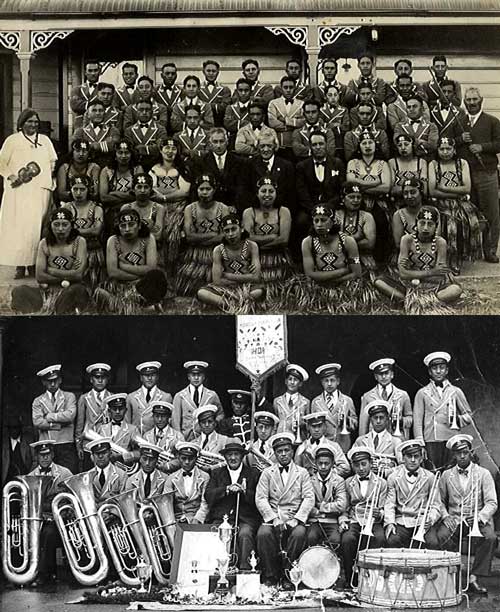
There were groups performing, which consisted of the Ratana Maori Lady’s Orchestra, Maori Culture, the Concert Party, and also different entertainment groups from around the country migrating into Ratana. In 1932, the first brass band was formulated and called Te Peene a te Mangai. In 1934, the silver band Arepa was formed followed by Te Reo Omeka. In 1935, the bands Piri Wiri Tua Hamuera were also formed.
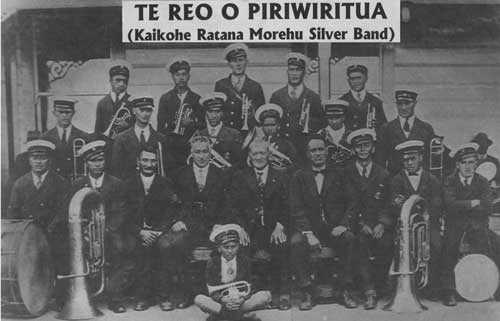
In 1935, Arepa had both a Silver and brass band. The silver represents the seniors and the brass representing the juniors. From this brass band section a secondary body was set-up to provide contemporary music and produce funds for Arepa. Ratana gave the name “Ratana Musicians Club.” (Editor WM Tane M, 1933: pg2: Editor WM Tane M, 1933: pp3-4)
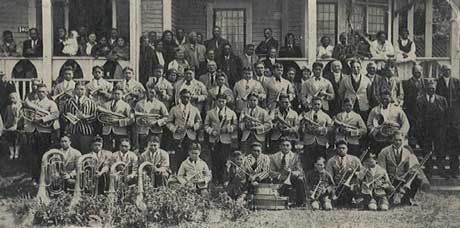
Ratana music draws its origins from Maori tradition Whakapapa, Moteatea, Whakawhanautanga Mauri and Culture Heritage to contemporary and modern innovations at most times integrating the two styles effectively. The Ratana concept is a two-fold mission. This consists of exciting and enticing the human spirit calling the promise of Ihoa. The duty to perform spiritual warfare the mission of Nga Reo katoa the spearhead against the powers of Maori sorcery and other evil entities. (Editor WM Tane, pg6: 1934)
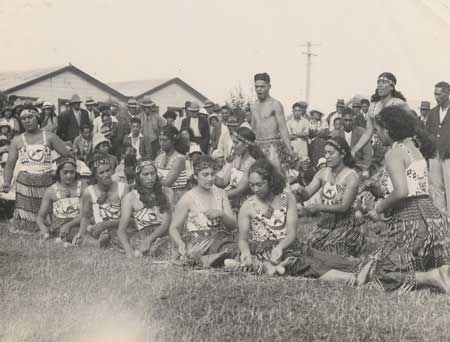
In December 1934 the Ratana Band lead the kings British Grenadier Guards into Marton playing the Ratana March. The conductor of the Ratana band was P.K.Paikea; the conductor of the Grenadier Guards was Major Miller.
(Editor WM Tane, 1934: pg6)
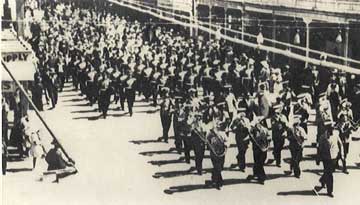
Archway Consecration (5th July 1935)
The Memorial Arch, which stands in front of the Temple, was unveiled and Consecrated on July 5th 1935. During the opening of the archway Ratana spoke with compassion and love, this became evident as the people who were gathered round the archway were overcome with ore as he spoke the final part of his speech to opened and consecrated the Archway.
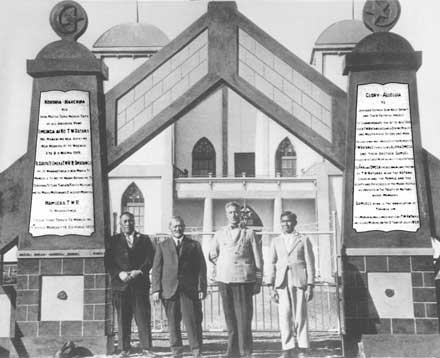
“O Jehovah, and your Faithful Angels, here we stand before this Memorial which, though made by us, your spirit instructed us to build.”
“We pledge in our hearts to always acknowledge that you are the giver of life that we may receive the fruits of life, and you that you will grant that we be protected from the bad works of the unbelievers and foreigners and all other such things that may harm us.”
“For you oh Jehovah, are the power, and I ask that you give strength to lead this people the Maori people 40,000 of them, as is written on this Memorial. Though there is others not included here, I pray that you, oh Jehovah, will gather them in, now and forever.”
“Verily, I establish and consecrate this Memorial and commend it to the breadth, heights and extremities of the heavens, as well as to the breadth, depths and extremities of the earth.
“I seal and consecrate it on this day to be so for ever and ever in hope that your glory may reach the four corners of the earth. I unveil it this day in the hope that in the time ahead its fruits shall be known.”
“Te Arepa- the beginning, Te Omeka the end, Hamuera the last full stop, Therefore, this treasured Memorial now stands revealed, from now on, the spirit will do its work you shall know its fruits.” (Editor WM Tane, 1935: pp2-5; Inscription on Memorial Archway Ratana Pa)
Work had proceeded with the clearing of the site for the Memorial Archway in 1934. The memorial was being erected for the South Island Maori who fell in the Great 1914-1918 War. Part of the Oamaru stone for the arch had arrived, and plans to start the work would be laboured by Maori craftsmen from the North Island. One year has passed since the Memorial was built; there had been many delays to unveil the memorial some issues resulted in the court forbidding the unveiling due to the raising of finance for the project. This resulted in the court forbidding the unveiling for another six months. Permission was finally granted in August 1934, for the ceremony to proceed, and the time taken up in negotiating an appropriate time for T.W.Ratana to unveil the monument.
Memorial Archway Temuka
- Commemorate the Ratana Movement and Ratana Church
- T.W.Ratana Sons, Te Arepa, Te Omeka
- Memorial to the Maori killed in the 1914-18 War (Roll of Honour)
Left Side Right Side
Johnson. W Ceary. J
Korako. H Karetai. S
Peneamene Manihera. W
Whitau. P Porete. A.R
Jacobs. H Rickus. T.S
Peneamene. W Whitau. A.J
Ratana.W Ratana. N
(Timaru Herald November 14th 1935)
Ratana and his party comprising 68 members arrived at 1.30am by car from Ashburton. They were received by 40 local Maori at the Arowhenua hall. Runanga member Mr N Waaka, the chairperson, welcomed the visitors to the hall. Visitors from Tuahiwi, Morven, Glenavy and Moeraki were also present at Arowhenua. Ratana and his Roopu were in Temuka to unveil the Arowhenua Memorial on Tuesday morning, but due to rain the unveiling was postponed. Tuesday evening a concert and dance was held for the people. Eruera Tihema Tirikatene was conducting his political campaign and the visitors included Tiaki Omana and Paraire Paikea Ratana candidates for Eastern Maori and Northern Maori, (Nga koata). Tirikatene delivered his speech to the Maori electors and was supported by the Rev Clyde Carr. (Timaru Herald, November 13th 1935: pg3)
The Arowhenua Memorial Archway was unveiled on the 13th November 1935, in the presence of T.W.Ratana on the Main South Road, led by the Morehu Silver Brass Band. Ratana delivered his speech to the congregation; the band played the hymn “Koutou Katoa Ra” followed by the choir singing a hymn. The shroud was removed from the memorial, followed by Ratana giving tribute in his speech pertaining to the Archway.
(Timaru Herald, November 15th 1935: pg13)

T.W.Ratana’s Speech spoken by E.T.Tirikatene: Eruera Tihema Tirikatene gave tribute to the people for the erection of the monument to the tribes represented from the four winds of the earth commenting by saying: “Let us be grateful” T.W.Ratana’s official greeting was read to the people by Eruera Tihema Tirikatene:
“The sacred soil of the South Island it stated “I salute you”. The descendents of those who have ventured on, I greet you. Greetings to you the Morehu (Remnants) of those great chiefs who now stand in the glory of the mighty planet, the sun, whose glorification spells beyond comprehension, the omni potence of God.”
“I greet you because of your Faith, hope and charity and I claim that through the erecting of this monument your love has been established upon earth permeating to the heavens, and the old adage must remain true. The earth is thy footstool and heaven thy throne.
“I greet you because you have found expedient to erect this monument to the memory of my sons, Alpha, Omega, Piri Wiri Tua, and Samuel, and also to the memory of your owns sons who gave their all in the great World War 1914-1918.”
“With regard to Alpha and Omega, these names have been spoken of long ago by one of your chiefs, Te Hipa Te Maiharoa, and since the inception of the Ratana Movement, Alpha and Omega, together with their brothers, stood on your court yards in view, the unity of the Maori race in order for it to enjoy the grace of God, the father, Son, Holy Spirit, and the ministering of their Faithful Angels.”
“Today we stand here before this sacred monument erected to the memory of those dear ones who have gone to the great beyond and to those who have fought for king and Country, and I claim that they are now in the spirit realm drawing us nearer and in a closer communion with the supreme Being.”
“I now stand before you, dear people, I who have sacrificed my all, and declare before you that I and my wife Mrs Ratana and my family come with love full of sincerity and say to you, “Unite yourselves for your rights and privileges as embodied in the Tiriti O Waitangi”.
“Dear people, if you desire to hold and maintain your identity as a Maori race, “Unite yourselves” and this is your only and last chance. In conclusion I and Mrs Ratana and my Candidates (Nga Koata) and party greet you. “Kia Ora Koutou”.Greetings were also delivered by Te Pahu Horomona, an elder of the Ngati Huirapa tribe. Ratana and his wife climbed the steps and passed through the archway. The Band followed and many of the people gathered followed behind the band to walk through the archway. At the end of the memorial greetings were again exchanged and the ceremony was concluded. Ratana and his concert party travelled to Timaru to perform a concert on Wednesday evening, where a unique concert was performed in the Scottish Hall. A splendid display of traditional Maori culture was given, the silver Band, played a well balance combination of tunes that featured several singers from the band. Poi dances, haka and action songs were performed. (Timaru Herald November 14th 1935; Editor WM Tane M No.563-565, 1935: pg3)
(1936 Period)
Go to T.W.Ratana Page (Political Page)
However, by 1936, T.W.Ratana, still maintained his work in both the spiritual and the physical realm making sure that his Morehu were well equipt to handle every day activities to assure their future growth. It was in April, that Ratana would visit the now popular Micky .G. Savage Prime Minister of Labour Party. Ratana his Roopu travelled to Wellington, to Parliament where a special meeting between the two men took place. Ratana placed before Mr Savage gifts as a memento of their meeting as well as a symbol of their unity under the law of the land.
(Editor WM Tane, 1936: pp7-8; Kara Book Pene K: 1990)
1937 Period Te Omeka Pa
In 1937, Ratana sent Tirikatene to England as a delegate to represent New Zealand Maori as a sentry at the post for the Kings Coronation Celebration at Buckingham Palace. Ratana called Tirikatene Tiri, short for the Tiriti o Waitangi. While Tirikatene was on duty, as a guard at the post, he removed his sabre from out of its pouch and accidentally cut one of his fingers and his blood began to flow onto the courtyard of the king. Ratana’s prophesy;
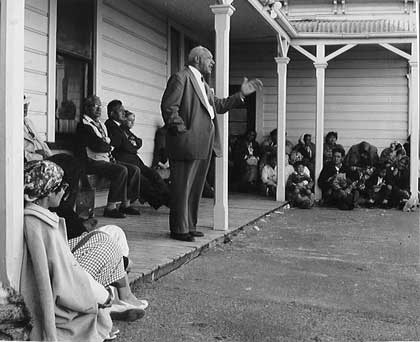
Ratana spoke to the people, I am now going to look for another Nation for me; the time is coming when I shall establish a powerhouse in Waikato, the Tiriti University. February 22nd 1937, T.W.Ratana Mangai travelled to Matamata where a second Marae was built Te Omeka Pa (Te Tiriki Teihana). Omeka Pa was officially opened with the presence of the Labour Party Cabinet Ministers. T.W.Ratana Mangai also warned the Government about passing bad laws upon the Maori people concerning the Treaty of Waitangi. In its evolution Te Omeka Pa was called “Te Tiriki Teihana” the powerhouse to monitor the problems of the people and to establish its role to support the physical and material well being of the Morehu and for the Maori people (Ture Tangata). Ratana wanted to engage with the Crown a partnership to uplift the Tiriti O Waitangi. He wanted Mickey Savage and Mr Langston to be present for the opening of Te Omeka Pa. He wanted to educate the Government and New Zealand public on the depth of the Tiriti O Waitangi and its spiritual ore why it was so precious to the Maori people. (Editor WM Tane M, pp7-8: 1933)
The 6th February is recognised for two reasons in the Ratana Movement and Ratana Church. The signing of the Tiriti O Waitangi and the opening of the Kii Koopu Cooking facility in the old Manuao. The Kii Koopu area was opened on the 6th of February 1938. The Morehu were led by the Reo (Band).
This was indeed a big day for Ratana Pa and the Morehu, for as well as the opening of the Manuao, the Prime Minister of New Zealand, and several guest were among the visitors was expected to visit Ratana for the opening of the facility. In talking to the people about the Manuao T.W.Ratana said no doubt people were wondering that since this was a Man-of-War, where are its Guns? Ratana replied that since the Head of Government is expected here today, it might be the right time for the Manuao’s guns to fire.
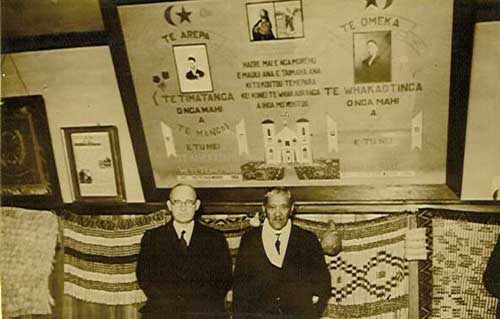
Buildings of the Ratana Church
he Temple was drawn up in 1926. The Kawenata was written up by T.W.Ratana Mangai for the protection of the workers who would be working on the Temple, which was due to start. The foundation of this Church was dedicated on the 5th July, 1925. Work was started on the Temple in 1926 and was completed at the end of 1927. Spiritual opening for the Temple took place on the 25th January 1927, by T.W.Ratana Te Mangai. The Physical opening of the Templeo the 25th Janaury 1928, was conducted by by Bishop Juji Nakata and T.W.Ratana Mangai, the last nail to to driven home through a Japanese coin. The building of the Temepara Tapu (Holy Temple) was a sign of Ratana completeing his spiritual mission. He was to leave the spirit of Te Mangai in the Temple in 1928. Many Marae converted to Ratana protocol and their Whare Tupuna were used as houses of prayer. In some cases Tribes buried their old meeting houses and built new ones dedicated to Ratana and his work, they still carry the name.
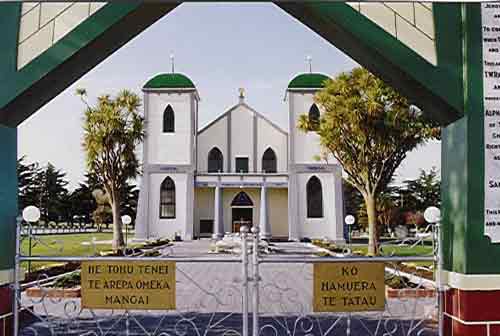
This was the first miniature Temple built outside Ratana Pa. The Morehu members from Raetihi supplied Ratana by gathering food for the workers who were helping to build this replica of the Temple. Ratana would stop at Raetihi when travelling north and on his way home. He referred to this Temple as his second door or gateway through which he would pass many times.
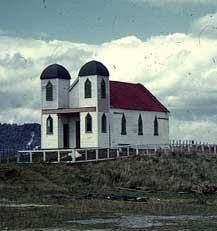
In memory of his 1920, Journey the people dedicated the Te Kao Temple to Ratana, it is built on land where Ratana once stood. The respect the people had for T.W.Ratana Mangai was the belief that he was the chosen one to set the Maori people free. The Morehu of the Tai Tokerau area have a pride tradition of upholding the teachings of the Ratana faith and may be found leading many Ratana Communities Nation wide.
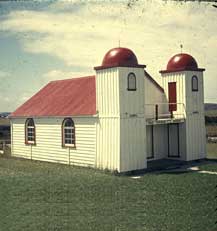
Since Ratana's first visit to the Far North in 1928, the mission on which he was to effect all of Maoridom by closing the spiritual Door (Te Rerenga Wairua) the spiritual door of the dead. This single act of faith captured the hearts of Te Aupouri Te Rarawa, Ngati Kuri, Nga Puhi, and Ngati Whatua due to the vast distance between Te Hapua and Ratana Pa. Many of the Elders decided to build replica's of the Temple so that they could continue to express their faith.

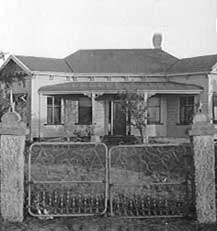
(WM No.296, November 30th 1929: pp3-49; WM No.293, November 9, 1929: pg7)
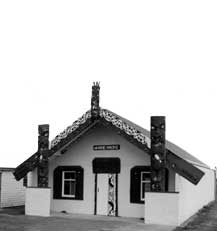
Original name given by T.W.Ratana Aunty Mere Rikiriki. Two houses were moved from Parewanui to Ratana Pa in 1924, Tikarina and Matangirei. Matangarei was destroyed by fire at Ratana before it was opened. The Tikarina was used as a administrational office for many years. The Ratana family continued to house guest and visitors there. Today Tikarina has had a new face lift and is still used to accomodate the extended family.
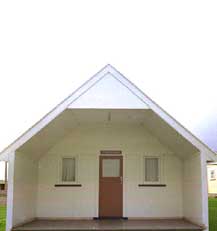
First official Ratana Church building opened in 1921, given the name Piki-Te-Ora used by Ratana as early focal point of his faith, it became the hospital in 1922, and when the new Temple was opened in 1927, it became the official Ratana Church Office. On the 8th October 1931, Piki Te Ora was closed and given over to the Methodist Mission, all further Official Ratana services were conducted in the Temple and all administrational duties moved to new premises around the Marae. Today the Piki Te Ora site is the Ratana Urupa (burial grounds).
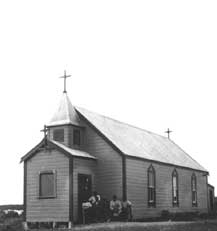
The Weslyan Mission Station founded by William Gittos in 1860, built this Church house on Maori land with Maori timber. When Ratana travelled north for the first time in 1921, he made it as far as Kaikohe. Many of the Northern tribes turned from European styled religions to follow the Ratana Movement and eventually the Ratana Church. Oruawharo was one of the first in the north to convert to this new faith and continue to be strong members of the faith today.
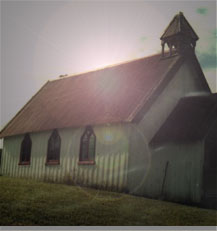
Under construction to be continued
